Develop Cultural Competence and Work Effectively with Aboriginal and/or Torres Strait Islander People
VerifiedAdded on 2022/11/25
|18
|4952
|363
AI Summary
This document discusses the importance of developing cultural competence and working effectively with Aboriginal and/or Torres Strait Islander people. It includes workplace tasks and strategies for supporting individual cultural identities. The document also provides examples of experiences and reflections from a small group of children aged 2-6 years.
Contribute Materials
Your contribution can guide someone’s learning journey. Share your
documents today.
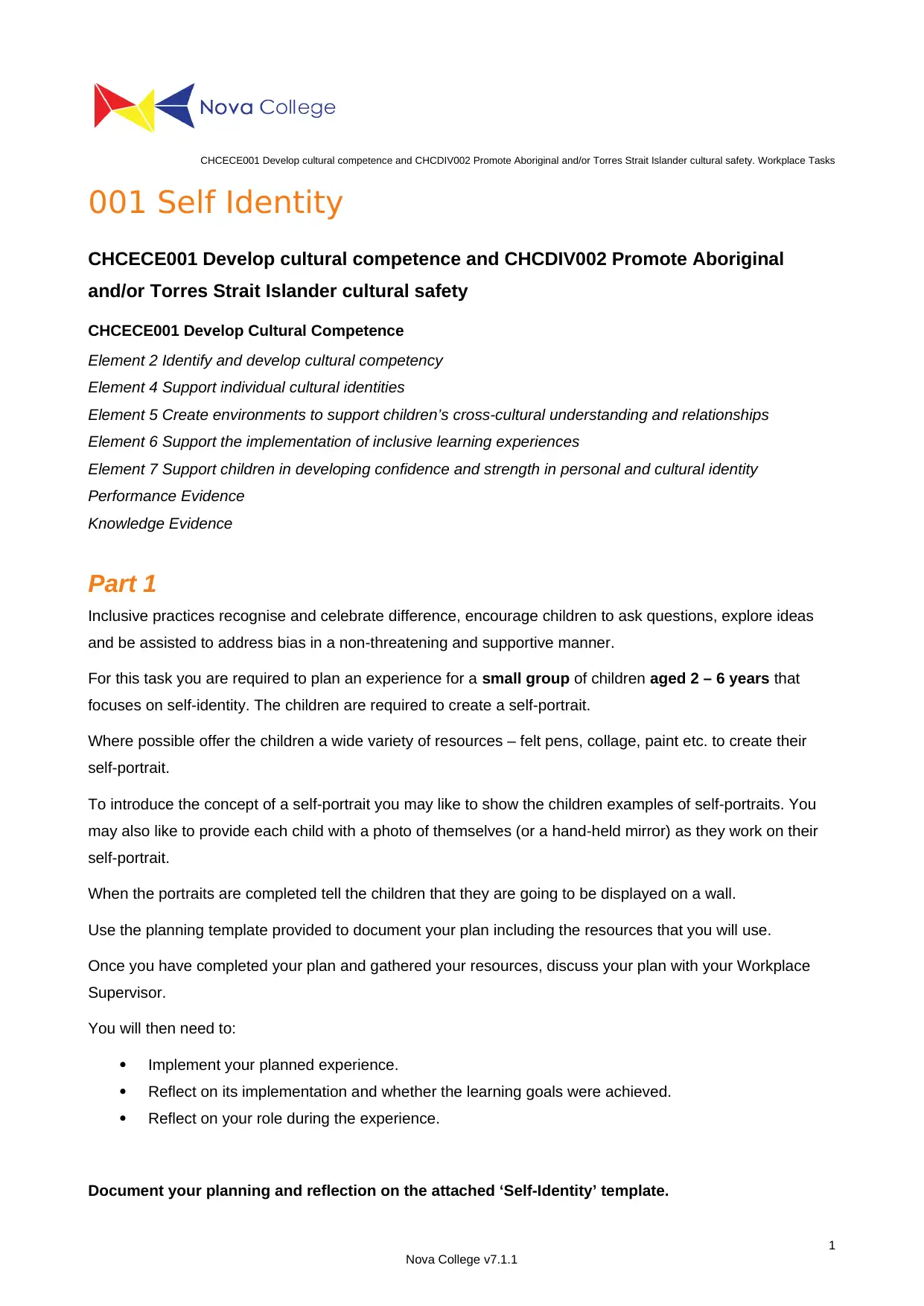
CHCECE001 Develop cultural competence and CHCDIV002 Promote Aboriginal and/or Torres Strait Islander cultural safety. Workplace Tasks
001 Self Identity
CHCECE001 Develop cultural competence and CHCDIV002 Promote Aboriginal
and/or Torres Strait Islander cultural safety
CHCECE001 Develop Cultural Competence
Element 2 Identify and develop cultural competency
Element 4 Support individual cultural identities
Element 5 Create environments to support children’s cross-cultural understanding and relationships
Element 6 Support the implementation of inclusive learning experiences
Element 7 Support children in developing confidence and strength in personal and cultural identity
Performance Evidence
Knowledge Evidence
Part 1
Inclusive practices recognise and celebrate difference, encourage children to ask questions, explore ideas
and be assisted to address bias in a non-threatening and supportive manner.
For this task you are required to plan an experience for a small group of children aged 2 – 6 years that
focuses on self-identity. The children are required to create a self-portrait.
Where possible offer the children a wide variety of resources – felt pens, collage, paint etc. to create their
self-portrait.
To introduce the concept of a self-portrait you may like to show the children examples of self-portraits. You
may also like to provide each child with a photo of themselves (or a hand-held mirror) as they work on their
self-portrait.
When the portraits are completed tell the children that they are going to be displayed on a wall.
Use the planning template provided to document your plan including the resources that you will use.
Once you have completed your plan and gathered your resources, discuss your plan with your Workplace
Supervisor.
You will then need to:
Implement your planned experience.
Reflect on its implementation and whether the learning goals were achieved.
Reflect on your role during the experience.
Document your planning and reflection on the attached ‘Self-Identity’ template.
1
Nova College v7.1.1
001 Self Identity
CHCECE001 Develop cultural competence and CHCDIV002 Promote Aboriginal
and/or Torres Strait Islander cultural safety
CHCECE001 Develop Cultural Competence
Element 2 Identify and develop cultural competency
Element 4 Support individual cultural identities
Element 5 Create environments to support children’s cross-cultural understanding and relationships
Element 6 Support the implementation of inclusive learning experiences
Element 7 Support children in developing confidence and strength in personal and cultural identity
Performance Evidence
Knowledge Evidence
Part 1
Inclusive practices recognise and celebrate difference, encourage children to ask questions, explore ideas
and be assisted to address bias in a non-threatening and supportive manner.
For this task you are required to plan an experience for a small group of children aged 2 – 6 years that
focuses on self-identity. The children are required to create a self-portrait.
Where possible offer the children a wide variety of resources – felt pens, collage, paint etc. to create their
self-portrait.
To introduce the concept of a self-portrait you may like to show the children examples of self-portraits. You
may also like to provide each child with a photo of themselves (or a hand-held mirror) as they work on their
self-portrait.
When the portraits are completed tell the children that they are going to be displayed on a wall.
Use the planning template provided to document your plan including the resources that you will use.
Once you have completed your plan and gathered your resources, discuss your plan with your Workplace
Supervisor.
You will then need to:
Implement your planned experience.
Reflect on its implementation and whether the learning goals were achieved.
Reflect on your role during the experience.
Document your planning and reflection on the attached ‘Self-Identity’ template.
1
Nova College v7.1.1
Secure Best Marks with AI Grader
Need help grading? Try our AI Grader for instant feedback on your assignments.
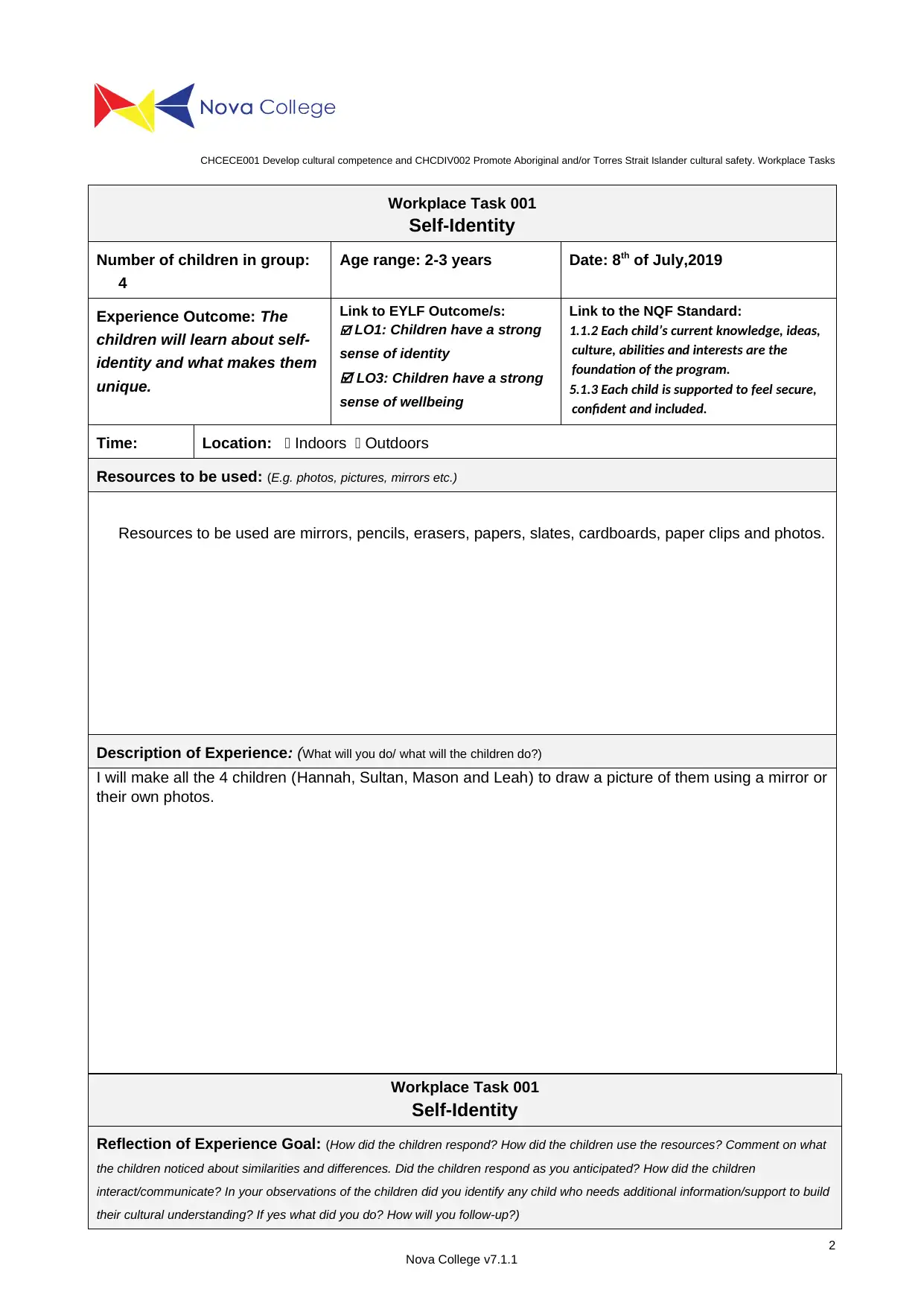
CHCECE001 Develop cultural competence and CHCDIV002 Promote Aboriginal and/or Torres Strait Islander cultural safety. Workplace Tasks
Workplace Task 001
Self-Identity
Number of children in group:
4
Age range: 2-3 years Date: 8th of July,2019
Experience Outcome: The
children will learn about self-
identity and what makes them
unique.
Link to EYLF Outcome/s:
LO1: Children have a strong
sense of identity
LO3: Children have a strong
sense of wellbeing
Link to the NQF Standard:
1.1.2 Each child’s current knowledge, ideas,
culture, abilities and interests are the
foundation of the program.
5.1.3 Each child is supported to feel secure,
confident and included.
Time: Location: Indoors Outdoors
Resources to be used: (E.g. photos, pictures, mirrors etc.)
Resources to be used are mirrors, pencils, erasers, papers, slates, cardboards, paper clips and photos.
Description of Experience: (What will you do/ what will the children do?)
I will make all the 4 children (Hannah, Sultan, Mason and Leah) to draw a picture of them using a mirror or
their own photos.
Workplace Task 001
Self-Identity
Reflection of Experience Goal: (How did the children respond? How did the children use the resources? Comment on what
the children noticed about similarities and differences. Did the children respond as you anticipated? How did the children
interact/communicate? In your observations of the children did you identify any child who needs additional information/support to build
their cultural understanding? If yes what did you do? How will you follow-up?)
2
Nova College v7.1.1
Workplace Task 001
Self-Identity
Number of children in group:
4
Age range: 2-3 years Date: 8th of July,2019
Experience Outcome: The
children will learn about self-
identity and what makes them
unique.
Link to EYLF Outcome/s:
LO1: Children have a strong
sense of identity
LO3: Children have a strong
sense of wellbeing
Link to the NQF Standard:
1.1.2 Each child’s current knowledge, ideas,
culture, abilities and interests are the
foundation of the program.
5.1.3 Each child is supported to feel secure,
confident and included.
Time: Location: Indoors Outdoors
Resources to be used: (E.g. photos, pictures, mirrors etc.)
Resources to be used are mirrors, pencils, erasers, papers, slates, cardboards, paper clips and photos.
Description of Experience: (What will you do/ what will the children do?)
I will make all the 4 children (Hannah, Sultan, Mason and Leah) to draw a picture of them using a mirror or
their own photos.
Workplace Task 001
Self-Identity
Reflection of Experience Goal: (How did the children respond? How did the children use the resources? Comment on what
the children noticed about similarities and differences. Did the children respond as you anticipated? How did the children
interact/communicate? In your observations of the children did you identify any child who needs additional information/support to build
their cultural understanding? If yes what did you do? How will you follow-up?)
2
Nova College v7.1.1
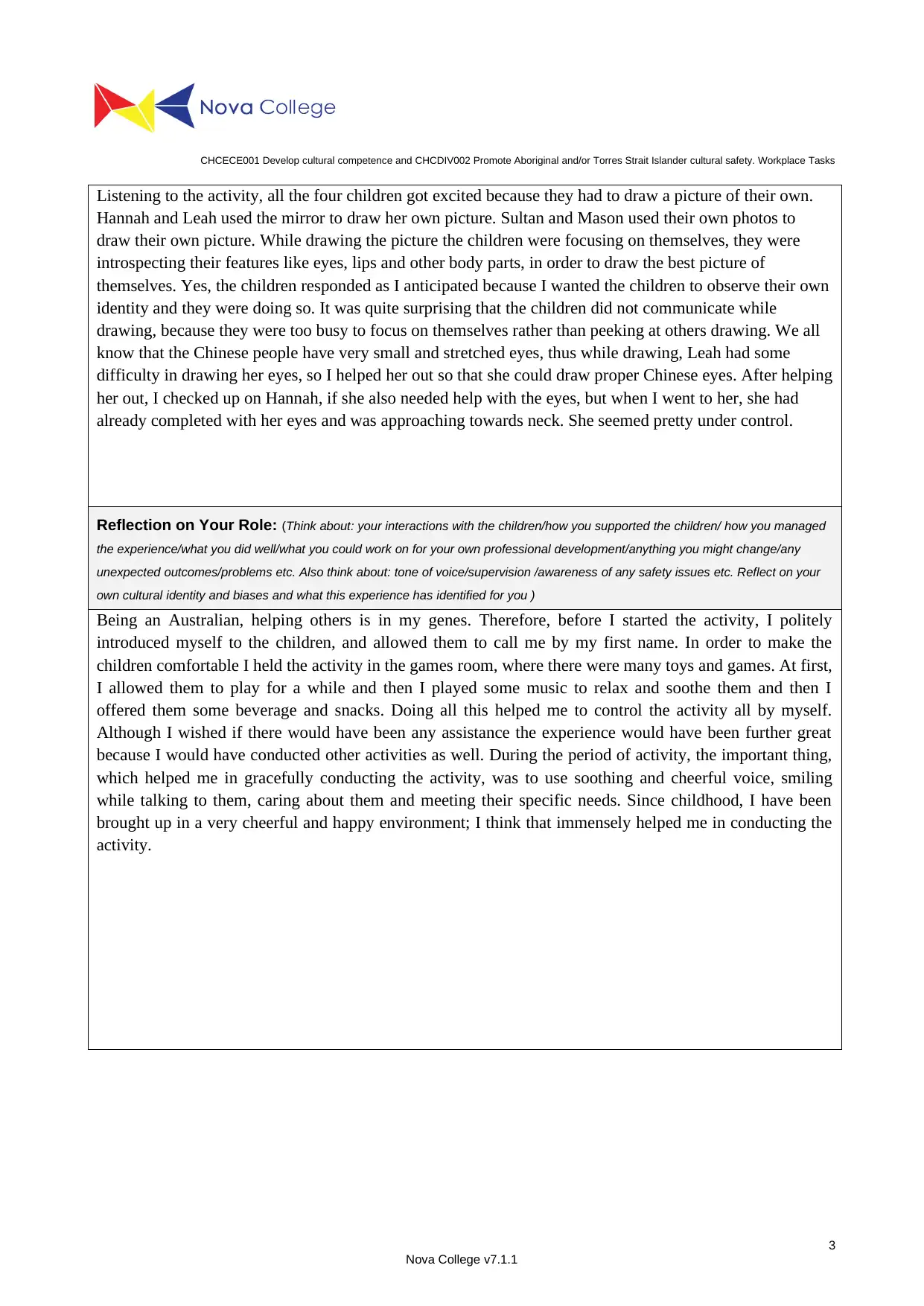
CHCECE001 Develop cultural competence and CHCDIV002 Promote Aboriginal and/or Torres Strait Islander cultural safety. Workplace Tasks
Listening to the activity, all the four children got excited because they had to draw a picture of their own.
Hannah and Leah used the mirror to draw her own picture. Sultan and Mason used their own photos to
draw their own picture. While drawing the picture the children were focusing on themselves, they were
introspecting their features like eyes, lips and other body parts, in order to draw the best picture of
themselves. Yes, the children responded as I anticipated because I wanted the children to observe their own
identity and they were doing so. It was quite surprising that the children did not communicate while
drawing, because they were too busy to focus on themselves rather than peeking at others drawing. We all
know that the Chinese people have very small and stretched eyes, thus while drawing, Leah had some
difficulty in drawing her eyes, so I helped her out so that she could draw proper Chinese eyes. After helping
her out, I checked up on Hannah, if she also needed help with the eyes, but when I went to her, she had
already completed with her eyes and was approaching towards neck. She seemed pretty under control.
Reflection on Your Role: (Think about: your interactions with the children/how you supported the children/ how you managed
the experience/what you did well/what you could work on for your own professional development/anything you might change/any
unexpected outcomes/problems etc. Also think about: tone of voice/supervision /awareness of any safety issues etc. Reflect on your
own cultural identity and biases and what this experience has identified for you )
Being an Australian, helping others is in my genes. Therefore, before I started the activity, I politely
introduced myself to the children, and allowed them to call me by my first name. In order to make the
children comfortable I held the activity in the games room, where there were many toys and games. At first,
I allowed them to play for a while and then I played some music to relax and soothe them and then I
offered them some beverage and snacks. Doing all this helped me to control the activity all by myself.
Although I wished if there would have been any assistance the experience would have been further great
because I would have conducted other activities as well. During the period of activity, the important thing,
which helped me in gracefully conducting the activity, was to use soothing and cheerful voice, smiling
while talking to them, caring about them and meeting their specific needs. Since childhood, I have been
brought up in a very cheerful and happy environment; I think that immensely helped me in conducting the
activity.
3
Nova College v7.1.1
Listening to the activity, all the four children got excited because they had to draw a picture of their own.
Hannah and Leah used the mirror to draw her own picture. Sultan and Mason used their own photos to
draw their own picture. While drawing the picture the children were focusing on themselves, they were
introspecting their features like eyes, lips and other body parts, in order to draw the best picture of
themselves. Yes, the children responded as I anticipated because I wanted the children to observe their own
identity and they were doing so. It was quite surprising that the children did not communicate while
drawing, because they were too busy to focus on themselves rather than peeking at others drawing. We all
know that the Chinese people have very small and stretched eyes, thus while drawing, Leah had some
difficulty in drawing her eyes, so I helped her out so that she could draw proper Chinese eyes. After helping
her out, I checked up on Hannah, if she also needed help with the eyes, but when I went to her, she had
already completed with her eyes and was approaching towards neck. She seemed pretty under control.
Reflection on Your Role: (Think about: your interactions with the children/how you supported the children/ how you managed
the experience/what you did well/what you could work on for your own professional development/anything you might change/any
unexpected outcomes/problems etc. Also think about: tone of voice/supervision /awareness of any safety issues etc. Reflect on your
own cultural identity and biases and what this experience has identified for you )
Being an Australian, helping others is in my genes. Therefore, before I started the activity, I politely
introduced myself to the children, and allowed them to call me by my first name. In order to make the
children comfortable I held the activity in the games room, where there were many toys and games. At first,
I allowed them to play for a while and then I played some music to relax and soothe them and then I
offered them some beverage and snacks. Doing all this helped me to control the activity all by myself.
Although I wished if there would have been any assistance the experience would have been further great
because I would have conducted other activities as well. During the period of activity, the important thing,
which helped me in gracefully conducting the activity, was to use soothing and cheerful voice, smiling
while talking to them, caring about them and meeting their specific needs. Since childhood, I have been
brought up in a very cheerful and happy environment; I think that immensely helped me in conducting the
activity.
3
Nova College v7.1.1
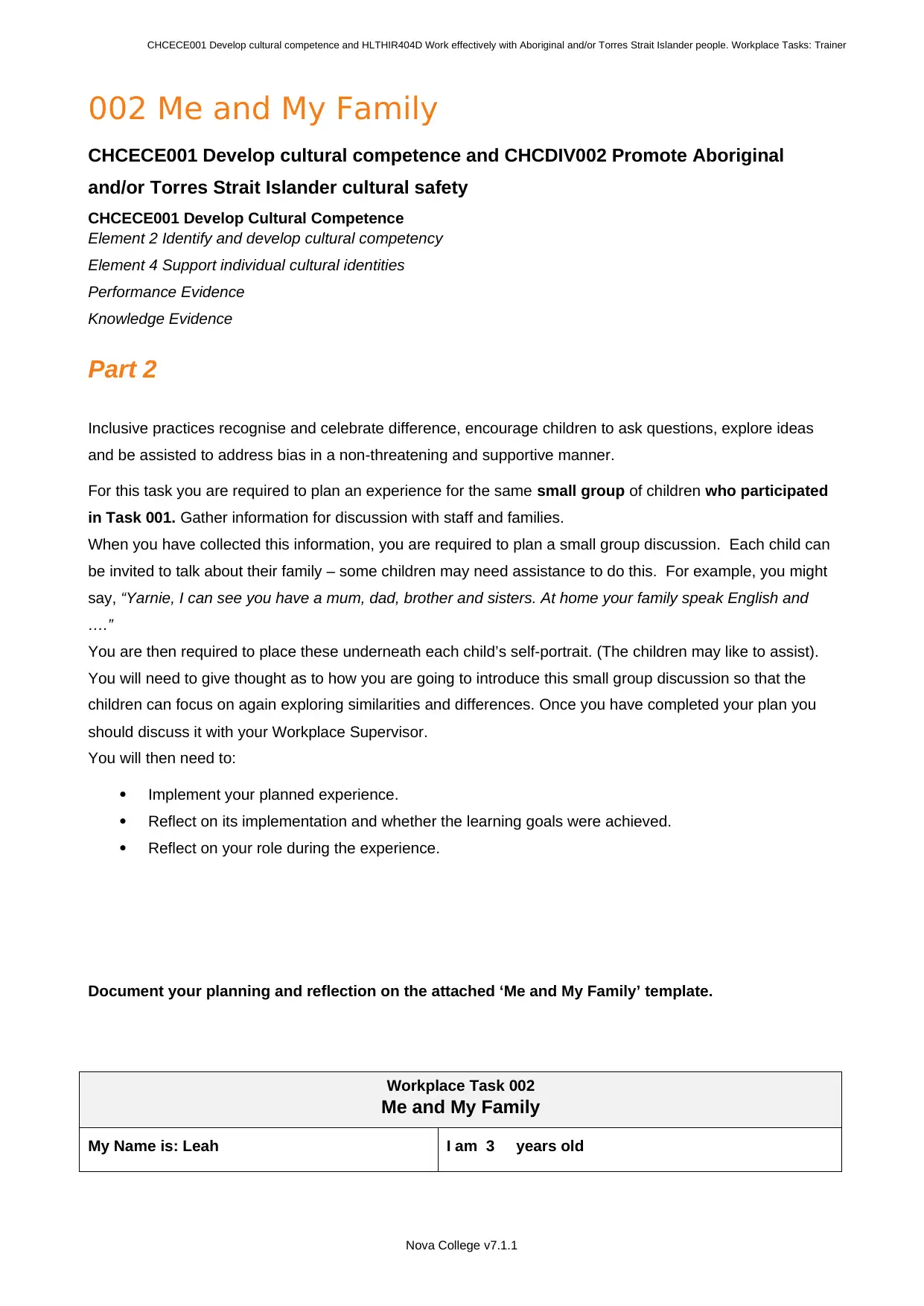
CHCECE001 Develop cultural competence and HLTHIR404D Work effectively with Aboriginal and/or Torres Strait Islander people. Workplace Tasks: Trainer
002 Me and My Family
CHCECE001 Develop cultural competence and CHCDIV002 Promote Aboriginal
and/or Torres Strait Islander cultural safety
CHCECE001 Develop Cultural Competence
Element 2 Identify and develop cultural competency
Element 4 Support individual cultural identities
Performance Evidence
Knowledge Evidence
Part 2
Inclusive practices recognise and celebrate difference, encourage children to ask questions, explore ideas
and be assisted to address bias in a non-threatening and supportive manner.
For this task you are required to plan an experience for the same small group of children who participated
in Task 001. Gather information for discussion with staff and families.
When you have collected this information, you are required to plan a small group discussion. Each child can
be invited to talk about their family – some children may need assistance to do this. For example, you might
say, “Yarnie, I can see you have a mum, dad, brother and sisters. At home your family speak English and
….”
You are then required to place these underneath each child’s self-portrait. (The children may like to assist).
You will need to give thought as to how you are going to introduce this small group discussion so that the
children can focus on again exploring similarities and differences. Once you have completed your plan you
should discuss it with your Workplace Supervisor.
You will then need to:
Implement your planned experience.
Reflect on its implementation and whether the learning goals were achieved.
Reflect on your role during the experience.
Document your planning and reflection on the attached ‘Me and My Family’ template.
Workplace Task 002
Me and My Family
My Name is: Leah I am 3 years old
Nova College v7.1.1
002 Me and My Family
CHCECE001 Develop cultural competence and CHCDIV002 Promote Aboriginal
and/or Torres Strait Islander cultural safety
CHCECE001 Develop Cultural Competence
Element 2 Identify and develop cultural competency
Element 4 Support individual cultural identities
Performance Evidence
Knowledge Evidence
Part 2
Inclusive practices recognise and celebrate difference, encourage children to ask questions, explore ideas
and be assisted to address bias in a non-threatening and supportive manner.
For this task you are required to plan an experience for the same small group of children who participated
in Task 001. Gather information for discussion with staff and families.
When you have collected this information, you are required to plan a small group discussion. Each child can
be invited to talk about their family – some children may need assistance to do this. For example, you might
say, “Yarnie, I can see you have a mum, dad, brother and sisters. At home your family speak English and
….”
You are then required to place these underneath each child’s self-portrait. (The children may like to assist).
You will need to give thought as to how you are going to introduce this small group discussion so that the
children can focus on again exploring similarities and differences. Once you have completed your plan you
should discuss it with your Workplace Supervisor.
You will then need to:
Implement your planned experience.
Reflect on its implementation and whether the learning goals were achieved.
Reflect on your role during the experience.
Document your planning and reflection on the attached ‘Me and My Family’ template.
Workplace Task 002
Me and My Family
My Name is: Leah I am 3 years old
Nova College v7.1.1
Secure Best Marks with AI Grader
Need help grading? Try our AI Grader for instant feedback on your assignments.
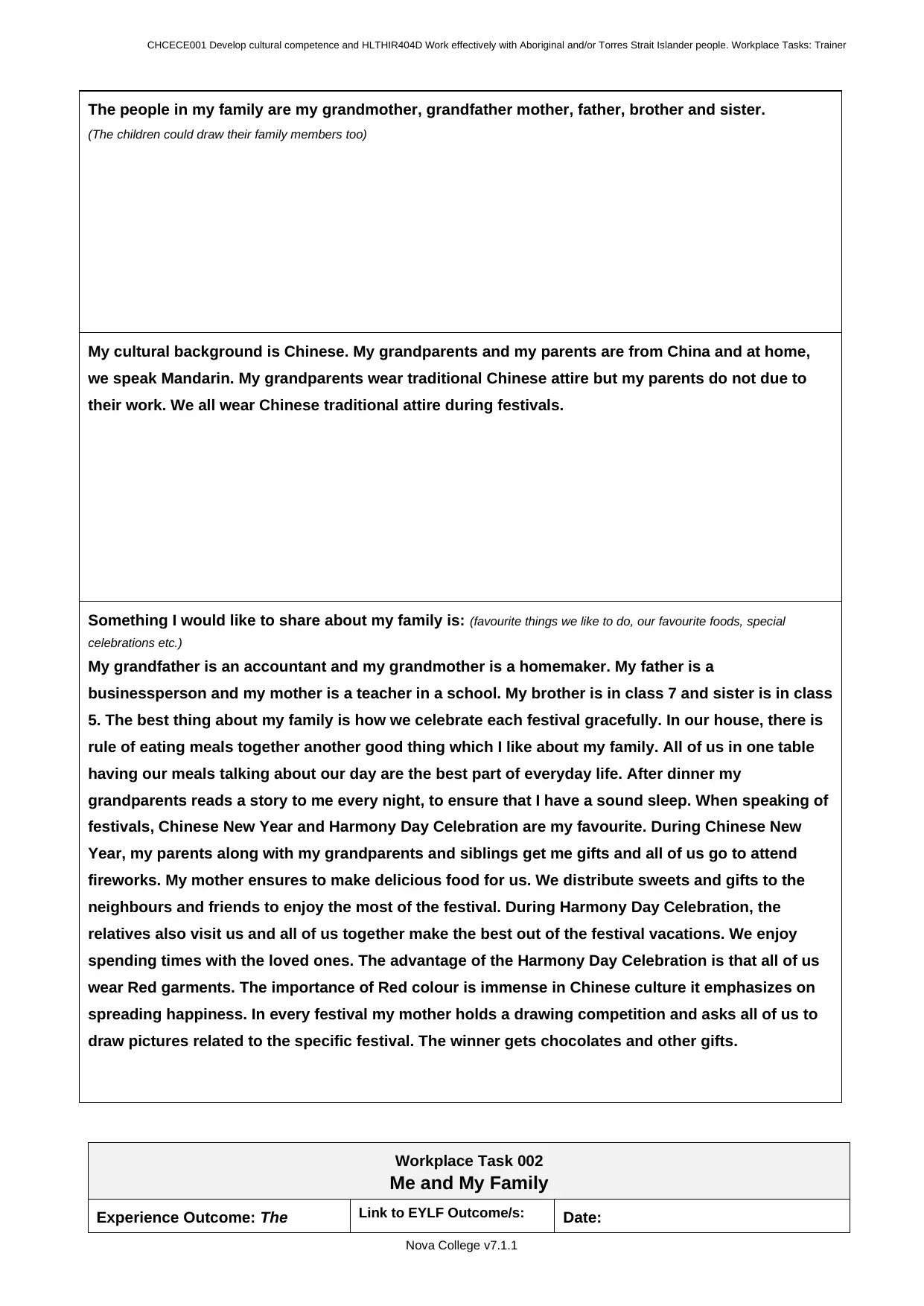
CHCECE001 Develop cultural competence and HLTHIR404D Work effectively with Aboriginal and/or Torres Strait Islander people. Workplace Tasks: Trainer
The people in my family are my grandmother, grandfather mother, father, brother and sister.
(The children could draw their family members too)
My cultural background is Chinese. My grandparents and my parents are from China and at home,
we speak Mandarin. My grandparents wear traditional Chinese attire but my parents do not due to
their work. We all wear Chinese traditional attire during festivals.
Something I would like to share about my family is: (favourite things we like to do, our favourite foods, special
celebrations etc.)
My grandfather is an accountant and my grandmother is a homemaker. My father is a
businessperson and my mother is a teacher in a school. My brother is in class 7 and sister is in class
5. The best thing about my family is how we celebrate each festival gracefully. In our house, there is
rule of eating meals together another good thing which I like about my family. All of us in one table
having our meals talking about our day are the best part of everyday life. After dinner my
grandparents reads a story to me every night, to ensure that I have a sound sleep. When speaking of
festivals, Chinese New Year and Harmony Day Celebration are my favourite. During Chinese New
Year, my parents along with my grandparents and siblings get me gifts and all of us go to attend
fireworks. My mother ensures to make delicious food for us. We distribute sweets and gifts to the
neighbours and friends to enjoy the most of the festival. During Harmony Day Celebration, the
relatives also visit us and all of us together make the best out of the festival vacations. We enjoy
spending times with the loved ones. The advantage of the Harmony Day Celebration is that all of us
wear Red garments. The importance of Red colour is immense in Chinese culture it emphasizes on
spreading happiness. In every festival my mother holds a drawing competition and asks all of us to
draw pictures related to the specific festival. The winner gets chocolates and other gifts.
Workplace Task 002
Me and My Family
Experience Outcome: The Link to EYLF Outcome/s: Date:
Nova College v7.1.1
The people in my family are my grandmother, grandfather mother, father, brother and sister.
(The children could draw their family members too)
My cultural background is Chinese. My grandparents and my parents are from China and at home,
we speak Mandarin. My grandparents wear traditional Chinese attire but my parents do not due to
their work. We all wear Chinese traditional attire during festivals.
Something I would like to share about my family is: (favourite things we like to do, our favourite foods, special
celebrations etc.)
My grandfather is an accountant and my grandmother is a homemaker. My father is a
businessperson and my mother is a teacher in a school. My brother is in class 7 and sister is in class
5. The best thing about my family is how we celebrate each festival gracefully. In our house, there is
rule of eating meals together another good thing which I like about my family. All of us in one table
having our meals talking about our day are the best part of everyday life. After dinner my
grandparents reads a story to me every night, to ensure that I have a sound sleep. When speaking of
festivals, Chinese New Year and Harmony Day Celebration are my favourite. During Chinese New
Year, my parents along with my grandparents and siblings get me gifts and all of us go to attend
fireworks. My mother ensures to make delicious food for us. We distribute sweets and gifts to the
neighbours and friends to enjoy the most of the festival. During Harmony Day Celebration, the
relatives also visit us and all of us together make the best out of the festival vacations. We enjoy
spending times with the loved ones. The advantage of the Harmony Day Celebration is that all of us
wear Red garments. The importance of Red colour is immense in Chinese culture it emphasizes on
spreading happiness. In every festival my mother holds a drawing competition and asks all of us to
draw pictures related to the specific festival. The winner gets chocolates and other gifts.
Workplace Task 002
Me and My Family
Experience Outcome: The Link to EYLF Outcome/s: Date:
Nova College v7.1.1
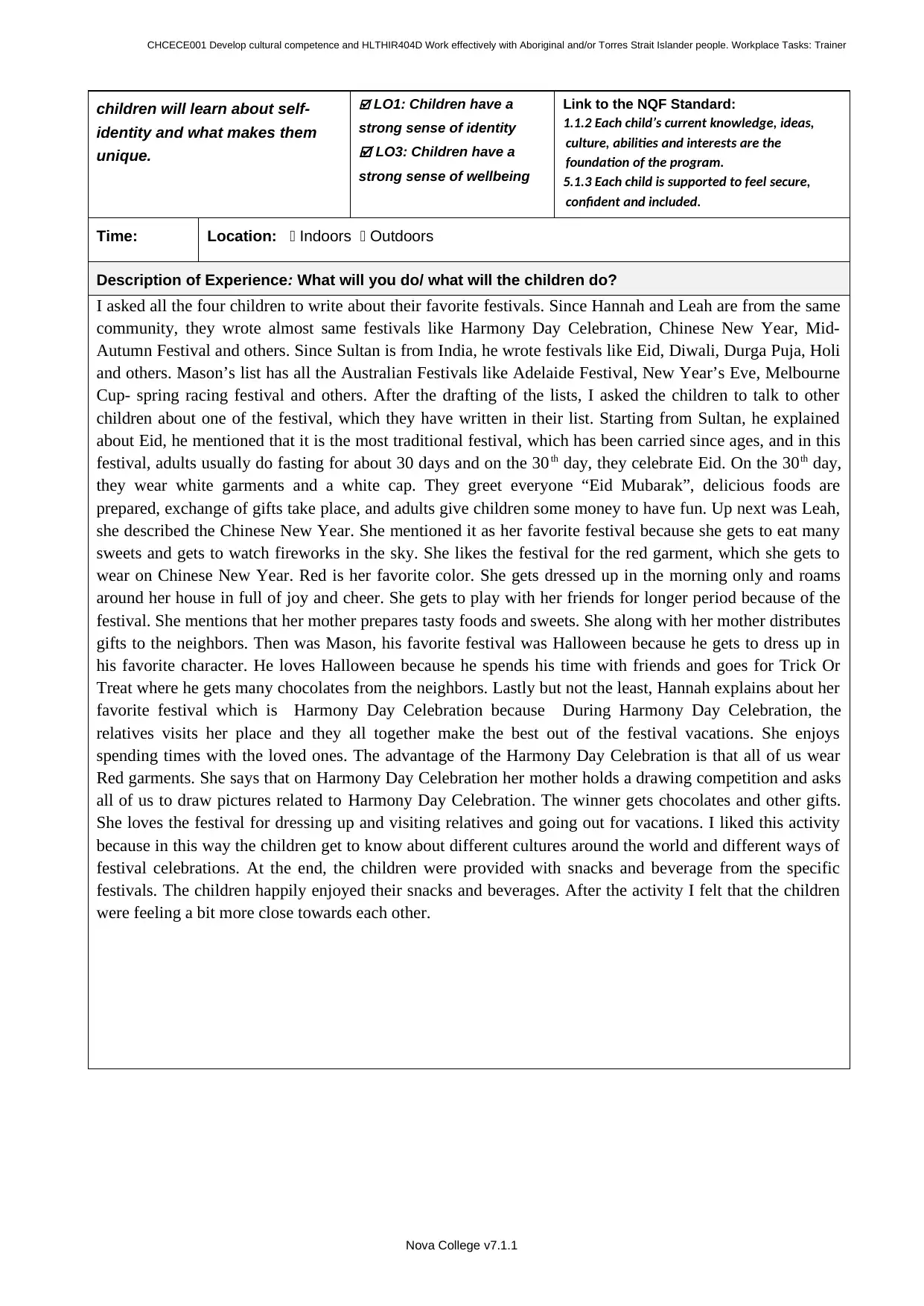
CHCECE001 Develop cultural competence and HLTHIR404D Work effectively with Aboriginal and/or Torres Strait Islander people. Workplace Tasks: Trainer
children will learn about self-
identity and what makes them
unique.
LO1: Children have a
strong sense of identity
LO3: Children have a
strong sense of wellbeing
Link to the NQF Standard:
1.1.2 Each child’s current knowledge, ideas,
culture, abilities and interests are the
foundation of the program.
5.1.3 Each child is supported to feel secure,
confident and included.
Time: Location: Indoors Outdoors
Description of Experience: What will you do/ what will the children do?
I asked all the four children to write about their favorite festivals. Since Hannah and Leah are from the same
community, they wrote almost same festivals like Harmony Day Celebration, Chinese New Year, Mid-
Autumn Festival and others. Since Sultan is from India, he wrote festivals like Eid, Diwali, Durga Puja, Holi
and others. Mason’s list has all the Australian Festivals like Adelaide Festival, New Year’s Eve, Melbourne
Cup- spring racing festival and others. After the drafting of the lists, I asked the children to talk to other
children about one of the festival, which they have written in their list. Starting from Sultan, he explained
about Eid, he mentioned that it is the most traditional festival, which has been carried since ages, and in this
festival, adults usually do fasting for about 30 days and on the 30th day, they celebrate Eid. On the 30th day,
they wear white garments and a white cap. They greet everyone “Eid Mubarak”, delicious foods are
prepared, exchange of gifts take place, and adults give children some money to have fun. Up next was Leah,
she described the Chinese New Year. She mentioned it as her favorite festival because she gets to eat many
sweets and gets to watch fireworks in the sky. She likes the festival for the red garment, which she gets to
wear on Chinese New Year. Red is her favorite color. She gets dressed up in the morning only and roams
around her house in full of joy and cheer. She gets to play with her friends for longer period because of the
festival. She mentions that her mother prepares tasty foods and sweets. She along with her mother distributes
gifts to the neighbors. Then was Mason, his favorite festival was Halloween because he gets to dress up in
his favorite character. He loves Halloween because he spends his time with friends and goes for Trick Or
Treat where he gets many chocolates from the neighbors. Lastly but not the least, Hannah explains about her
favorite festival which is Harmony Day Celebration because During Harmony Day Celebration, the
relatives visits her place and they all together make the best out of the festival vacations. She enjoys
spending times with the loved ones. The advantage of the Harmony Day Celebration is that all of us wear
Red garments. She says that on Harmony Day Celebration her mother holds a drawing competition and asks
all of us to draw pictures related to Harmony Day Celebration. The winner gets chocolates and other gifts.
She loves the festival for dressing up and visiting relatives and going out for vacations. I liked this activity
because in this way the children get to know about different cultures around the world and different ways of
festival celebrations. At the end, the children were provided with snacks and beverage from the specific
festivals. The children happily enjoyed their snacks and beverages. After the activity I felt that the children
were feeling a bit more close towards each other.
Nova College v7.1.1
children will learn about self-
identity and what makes them
unique.
LO1: Children have a
strong sense of identity
LO3: Children have a
strong sense of wellbeing
Link to the NQF Standard:
1.1.2 Each child’s current knowledge, ideas,
culture, abilities and interests are the
foundation of the program.
5.1.3 Each child is supported to feel secure,
confident and included.
Time: Location: Indoors Outdoors
Description of Experience: What will you do/ what will the children do?
I asked all the four children to write about their favorite festivals. Since Hannah and Leah are from the same
community, they wrote almost same festivals like Harmony Day Celebration, Chinese New Year, Mid-
Autumn Festival and others. Since Sultan is from India, he wrote festivals like Eid, Diwali, Durga Puja, Holi
and others. Mason’s list has all the Australian Festivals like Adelaide Festival, New Year’s Eve, Melbourne
Cup- spring racing festival and others. After the drafting of the lists, I asked the children to talk to other
children about one of the festival, which they have written in their list. Starting from Sultan, he explained
about Eid, he mentioned that it is the most traditional festival, which has been carried since ages, and in this
festival, adults usually do fasting for about 30 days and on the 30th day, they celebrate Eid. On the 30th day,
they wear white garments and a white cap. They greet everyone “Eid Mubarak”, delicious foods are
prepared, exchange of gifts take place, and adults give children some money to have fun. Up next was Leah,
she described the Chinese New Year. She mentioned it as her favorite festival because she gets to eat many
sweets and gets to watch fireworks in the sky. She likes the festival for the red garment, which she gets to
wear on Chinese New Year. Red is her favorite color. She gets dressed up in the morning only and roams
around her house in full of joy and cheer. She gets to play with her friends for longer period because of the
festival. She mentions that her mother prepares tasty foods and sweets. She along with her mother distributes
gifts to the neighbors. Then was Mason, his favorite festival was Halloween because he gets to dress up in
his favorite character. He loves Halloween because he spends his time with friends and goes for Trick Or
Treat where he gets many chocolates from the neighbors. Lastly but not the least, Hannah explains about her
favorite festival which is Harmony Day Celebration because During Harmony Day Celebration, the
relatives visits her place and they all together make the best out of the festival vacations. She enjoys
spending times with the loved ones. The advantage of the Harmony Day Celebration is that all of us wear
Red garments. She says that on Harmony Day Celebration her mother holds a drawing competition and asks
all of us to draw pictures related to Harmony Day Celebration. The winner gets chocolates and other gifts.
She loves the festival for dressing up and visiting relatives and going out for vacations. I liked this activity
because in this way the children get to know about different cultures around the world and different ways of
festival celebrations. At the end, the children were provided with snacks and beverage from the specific
festivals. The children happily enjoyed their snacks and beverages. After the activity I felt that the children
were feeling a bit more close towards each other.
Nova College v7.1.1
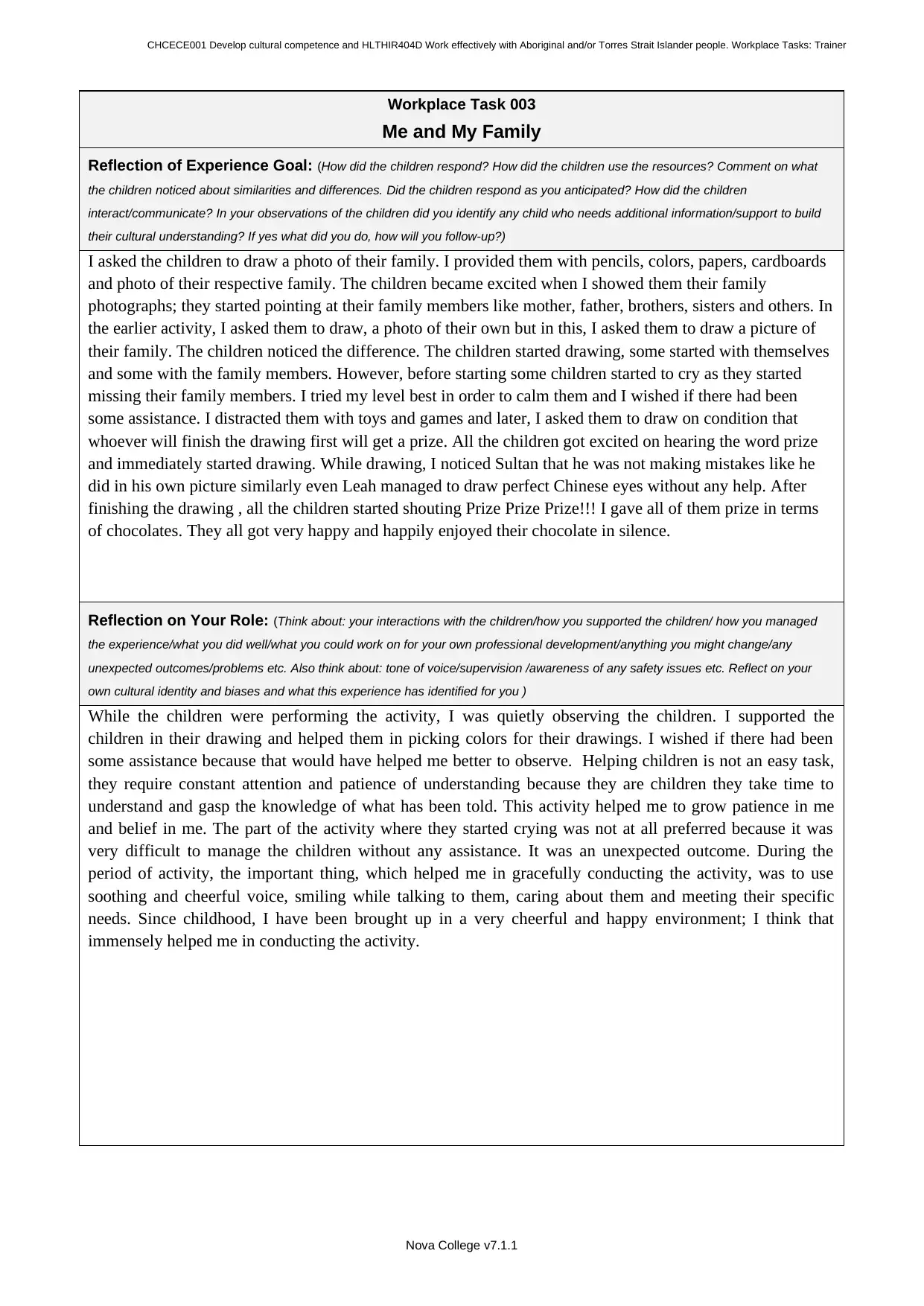
CHCECE001 Develop cultural competence and HLTHIR404D Work effectively with Aboriginal and/or Torres Strait Islander people. Workplace Tasks: Trainer
Workplace Task 003
Me and My Family
Reflection of Experience Goal: (How did the children respond? How did the children use the resources? Comment on what
the children noticed about similarities and differences. Did the children respond as you anticipated? How did the children
interact/communicate? In your observations of the children did you identify any child who needs additional information/support to build
their cultural understanding? If yes what did you do, how will you follow-up?)
I asked the children to draw a photo of their family. I provided them with pencils, colors, papers, cardboards
and photo of their respective family. The children became excited when I showed them their family
photographs; they started pointing at their family members like mother, father, brothers, sisters and others. In
the earlier activity, I asked them to draw, a photo of their own but in this, I asked them to draw a picture of
their family. The children noticed the difference. The children started drawing, some started with themselves
and some with the family members. However, before starting some children started to cry as they started
missing their family members. I tried my level best in order to calm them and I wished if there had been
some assistance. I distracted them with toys and games and later, I asked them to draw on condition that
whoever will finish the drawing first will get a prize. All the children got excited on hearing the word prize
and immediately started drawing. While drawing, I noticed Sultan that he was not making mistakes like he
did in his own picture similarly even Leah managed to draw perfect Chinese eyes without any help. After
finishing the drawing , all the children started shouting Prize Prize Prize!!! I gave all of them prize in terms
of chocolates. They all got very happy and happily enjoyed their chocolate in silence.
Reflection on Your Role: (Think about: your interactions with the children/how you supported the children/ how you managed
the experience/what you did well/what you could work on for your own professional development/anything you might change/any
unexpected outcomes/problems etc. Also think about: tone of voice/supervision /awareness of any safety issues etc. Reflect on your
own cultural identity and biases and what this experience has identified for you )
While the children were performing the activity, I was quietly observing the children. I supported the
children in their drawing and helped them in picking colors for their drawings. I wished if there had been
some assistance because that would have helped me better to observe. Helping children is not an easy task,
they require constant attention and patience of understanding because they are children they take time to
understand and gasp the knowledge of what has been told. This activity helped me to grow patience in me
and belief in me. The part of the activity where they started crying was not at all preferred because it was
very difficult to manage the children without any assistance. It was an unexpected outcome. During the
period of activity, the important thing, which helped me in gracefully conducting the activity, was to use
soothing and cheerful voice, smiling while talking to them, caring about them and meeting their specific
needs. Since childhood, I have been brought up in a very cheerful and happy environment; I think that
immensely helped me in conducting the activity.
Nova College v7.1.1
Workplace Task 003
Me and My Family
Reflection of Experience Goal: (How did the children respond? How did the children use the resources? Comment on what
the children noticed about similarities and differences. Did the children respond as you anticipated? How did the children
interact/communicate? In your observations of the children did you identify any child who needs additional information/support to build
their cultural understanding? If yes what did you do, how will you follow-up?)
I asked the children to draw a photo of their family. I provided them with pencils, colors, papers, cardboards
and photo of their respective family. The children became excited when I showed them their family
photographs; they started pointing at their family members like mother, father, brothers, sisters and others. In
the earlier activity, I asked them to draw, a photo of their own but in this, I asked them to draw a picture of
their family. The children noticed the difference. The children started drawing, some started with themselves
and some with the family members. However, before starting some children started to cry as they started
missing their family members. I tried my level best in order to calm them and I wished if there had been
some assistance. I distracted them with toys and games and later, I asked them to draw on condition that
whoever will finish the drawing first will get a prize. All the children got excited on hearing the word prize
and immediately started drawing. While drawing, I noticed Sultan that he was not making mistakes like he
did in his own picture similarly even Leah managed to draw perfect Chinese eyes without any help. After
finishing the drawing , all the children started shouting Prize Prize Prize!!! I gave all of them prize in terms
of chocolates. They all got very happy and happily enjoyed their chocolate in silence.
Reflection on Your Role: (Think about: your interactions with the children/how you supported the children/ how you managed
the experience/what you did well/what you could work on for your own professional development/anything you might change/any
unexpected outcomes/problems etc. Also think about: tone of voice/supervision /awareness of any safety issues etc. Reflect on your
own cultural identity and biases and what this experience has identified for you )
While the children were performing the activity, I was quietly observing the children. I supported the
children in their drawing and helped them in picking colors for their drawings. I wished if there had been
some assistance because that would have helped me better to observe. Helping children is not an easy task,
they require constant attention and patience of understanding because they are children they take time to
understand and gasp the knowledge of what has been told. This activity helped me to grow patience in me
and belief in me. The part of the activity where they started crying was not at all preferred because it was
very difficult to manage the children without any assistance. It was an unexpected outcome. During the
period of activity, the important thing, which helped me in gracefully conducting the activity, was to use
soothing and cheerful voice, smiling while talking to them, caring about them and meeting their specific
needs. Since childhood, I have been brought up in a very cheerful and happy environment; I think that
immensely helped me in conducting the activity.
Nova College v7.1.1
Paraphrase This Document
Need a fresh take? Get an instant paraphrase of this document with our AI Paraphraser
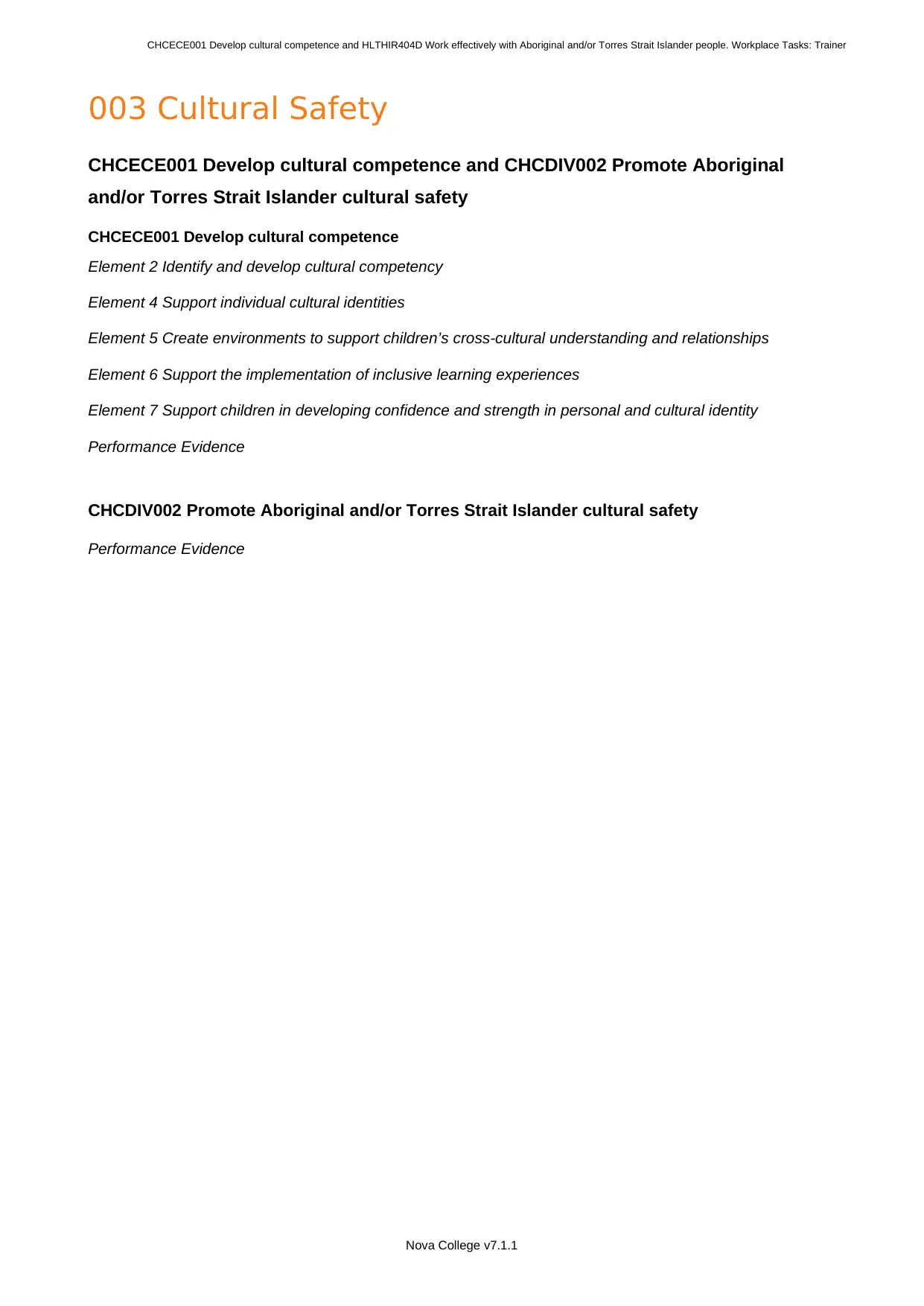
CHCECE001 Develop cultural competence and HLTHIR404D Work effectively with Aboriginal and/or Torres Strait Islander people. Workplace Tasks: Trainer
003 Cultural Safety
CHCECE001 Develop cultural competence and CHCDIV002 Promote Aboriginal
and/or Torres Strait Islander cultural safety
CHCECE001 Develop cultural competence
Element 2 Identify and develop cultural competency
Element 4 Support individual cultural identities
Element 5 Create environments to support children’s cross-cultural understanding and relationships
Element 6 Support the implementation of inclusive learning experiences
Element 7 Support children in developing confidence and strength in personal and cultural identity
Performance Evidence
CHCDIV002 Promote Aboriginal and/or Torres Strait Islander cultural safety
Performance Evidence
Nova College v7.1.1
003 Cultural Safety
CHCECE001 Develop cultural competence and CHCDIV002 Promote Aboriginal
and/or Torres Strait Islander cultural safety
CHCECE001 Develop cultural competence
Element 2 Identify and develop cultural competency
Element 4 Support individual cultural identities
Element 5 Create environments to support children’s cross-cultural understanding and relationships
Element 6 Support the implementation of inclusive learning experiences
Element 7 Support children in developing confidence and strength in personal and cultural identity
Performance Evidence
CHCDIV002 Promote Aboriginal and/or Torres Strait Islander cultural safety
Performance Evidence
Nova College v7.1.1
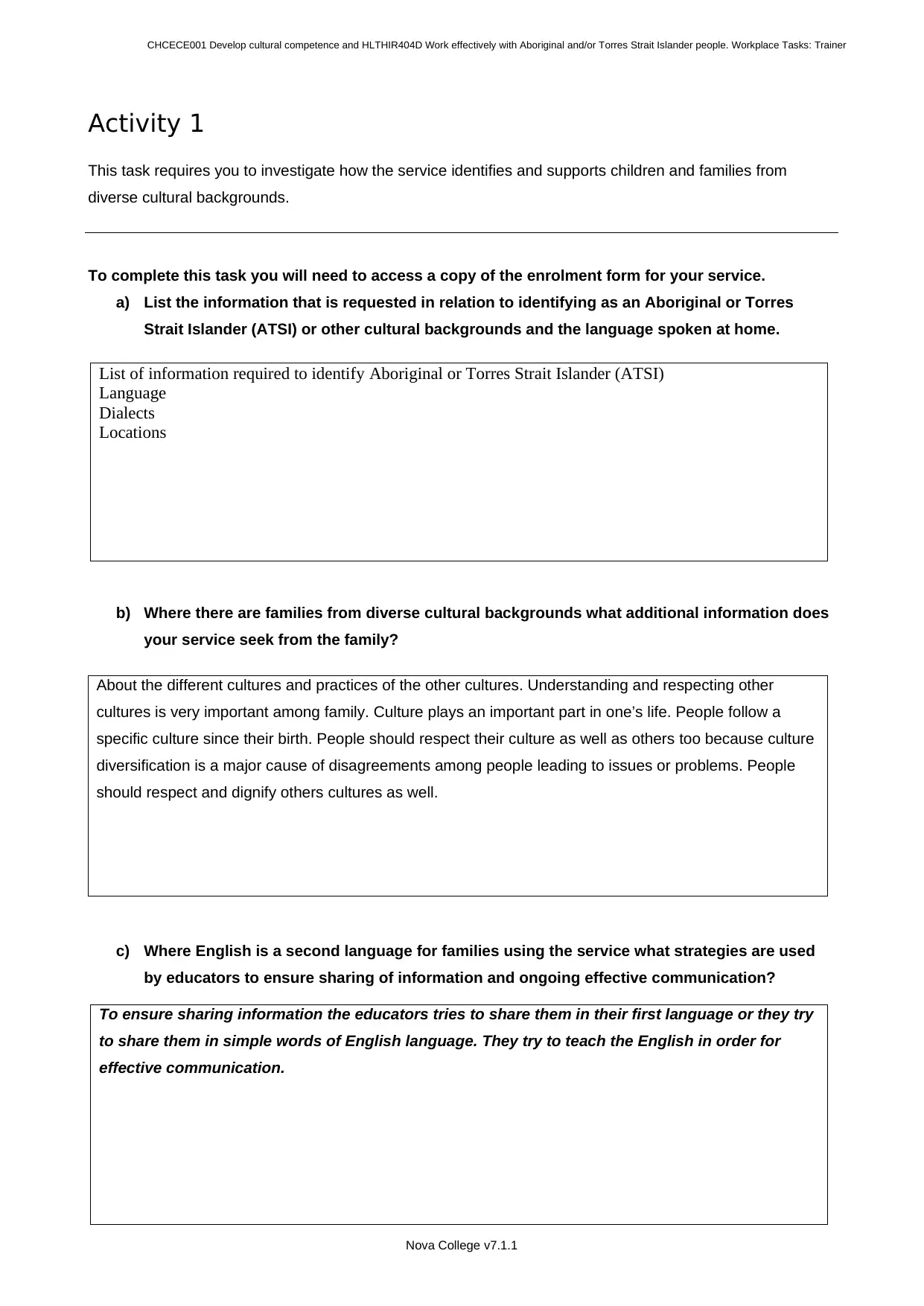
CHCECE001 Develop cultural competence and HLTHIR404D Work effectively with Aboriginal and/or Torres Strait Islander people. Workplace Tasks: Trainer
Activity 1
This task requires you to investigate how the service identifies and supports children and families from
diverse cultural backgrounds.
To complete this task you will need to access a copy of the enrolment form for your service.
a) List the information that is requested in relation to identifying as an Aboriginal or Torres
Strait Islander (ATSI) or other cultural backgrounds and the language spoken at home.
List of information required to identify Aboriginal or Torres Strait Islander (ATSI)
Language
Dialects
Locations
b) Where there are families from diverse cultural backgrounds what additional information does
your service seek from the family?
About the different cultures and practices of the other cultures. Understanding and respecting other
cultures is very important among family. Culture plays an important part in one’s life. People follow a
specific culture since their birth. People should respect their culture as well as others too because culture
diversification is a major cause of disagreements among people leading to issues or problems. People
should respect and dignify others cultures as well.
c) Where English is a second language for families using the service what strategies are used
by educators to ensure sharing of information and ongoing effective communication?
To ensure sharing information the educators tries to share them in their first language or they try
to share them in simple words of English language. They try to teach the English in order for
effective communication.
Nova College v7.1.1
Activity 1
This task requires you to investigate how the service identifies and supports children and families from
diverse cultural backgrounds.
To complete this task you will need to access a copy of the enrolment form for your service.
a) List the information that is requested in relation to identifying as an Aboriginal or Torres
Strait Islander (ATSI) or other cultural backgrounds and the language spoken at home.
List of information required to identify Aboriginal or Torres Strait Islander (ATSI)
Language
Dialects
Locations
b) Where there are families from diverse cultural backgrounds what additional information does
your service seek from the family?
About the different cultures and practices of the other cultures. Understanding and respecting other
cultures is very important among family. Culture plays an important part in one’s life. People follow a
specific culture since their birth. People should respect their culture as well as others too because culture
diversification is a major cause of disagreements among people leading to issues or problems. People
should respect and dignify others cultures as well.
c) Where English is a second language for families using the service what strategies are used
by educators to ensure sharing of information and ongoing effective communication?
To ensure sharing information the educators tries to share them in their first language or they try
to share them in simple words of English language. They try to teach the English in order for
effective communication.
Nova College v7.1.1
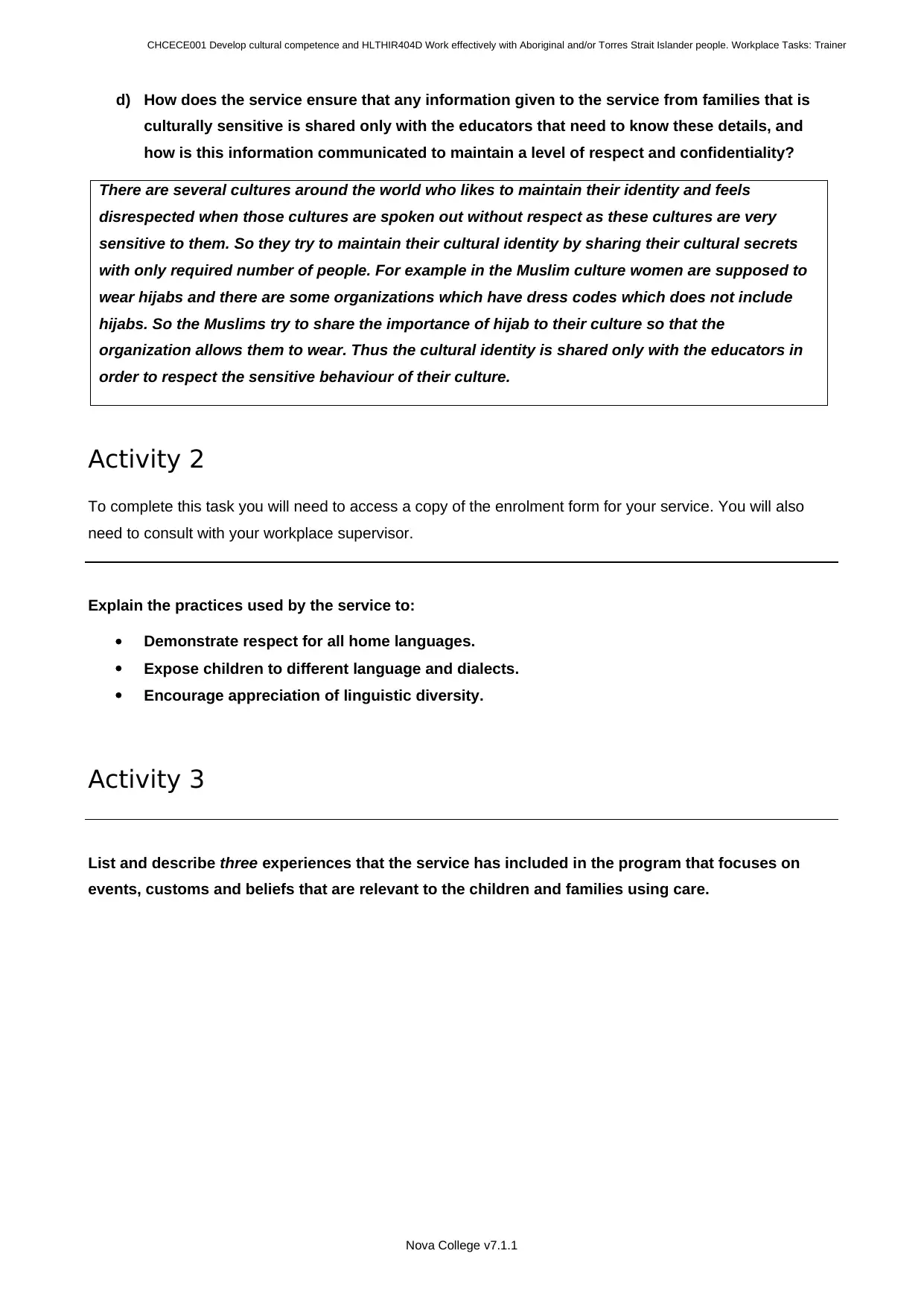
CHCECE001 Develop cultural competence and HLTHIR404D Work effectively with Aboriginal and/or Torres Strait Islander people. Workplace Tasks: Trainer
d) How does the service ensure that any information given to the service from families that is
culturally sensitive is shared only with the educators that need to know these details, and
how is this information communicated to maintain a level of respect and confidentiality?
There are several cultures around the world who likes to maintain their identity and feels
disrespected when those cultures are spoken out without respect as these cultures are very
sensitive to them. So they try to maintain their cultural identity by sharing their cultural secrets
with only required number of people. For example in the Muslim culture women are supposed to
wear hijabs and there are some organizations which have dress codes which does not include
hijabs. So the Muslims try to share the importance of hijab to their culture so that the
organization allows them to wear. Thus the cultural identity is shared only with the educators in
order to respect the sensitive behaviour of their culture.
Activity 2
To complete this task you will need to access a copy of the enrolment form for your service. You will also
need to consult with your workplace supervisor.
Explain the practices used by the service to:
Demonstrate respect for all home languages.
Expose children to different language and dialects.
Encourage appreciation of linguistic diversity.
Activity 3
List and describe three experiences that the service has included in the program that focuses on
events, customs and beliefs that are relevant to the children and families using care.
Nova College v7.1.1
d) How does the service ensure that any information given to the service from families that is
culturally sensitive is shared only with the educators that need to know these details, and
how is this information communicated to maintain a level of respect and confidentiality?
There are several cultures around the world who likes to maintain their identity and feels
disrespected when those cultures are spoken out without respect as these cultures are very
sensitive to them. So they try to maintain their cultural identity by sharing their cultural secrets
with only required number of people. For example in the Muslim culture women are supposed to
wear hijabs and there are some organizations which have dress codes which does not include
hijabs. So the Muslims try to share the importance of hijab to their culture so that the
organization allows them to wear. Thus the cultural identity is shared only with the educators in
order to respect the sensitive behaviour of their culture.
Activity 2
To complete this task you will need to access a copy of the enrolment form for your service. You will also
need to consult with your workplace supervisor.
Explain the practices used by the service to:
Demonstrate respect for all home languages.
Expose children to different language and dialects.
Encourage appreciation of linguistic diversity.
Activity 3
List and describe three experiences that the service has included in the program that focuses on
events, customs and beliefs that are relevant to the children and families using care.
Nova College v7.1.1
Secure Best Marks with AI Grader
Need help grading? Try our AI Grader for instant feedback on your assignments.
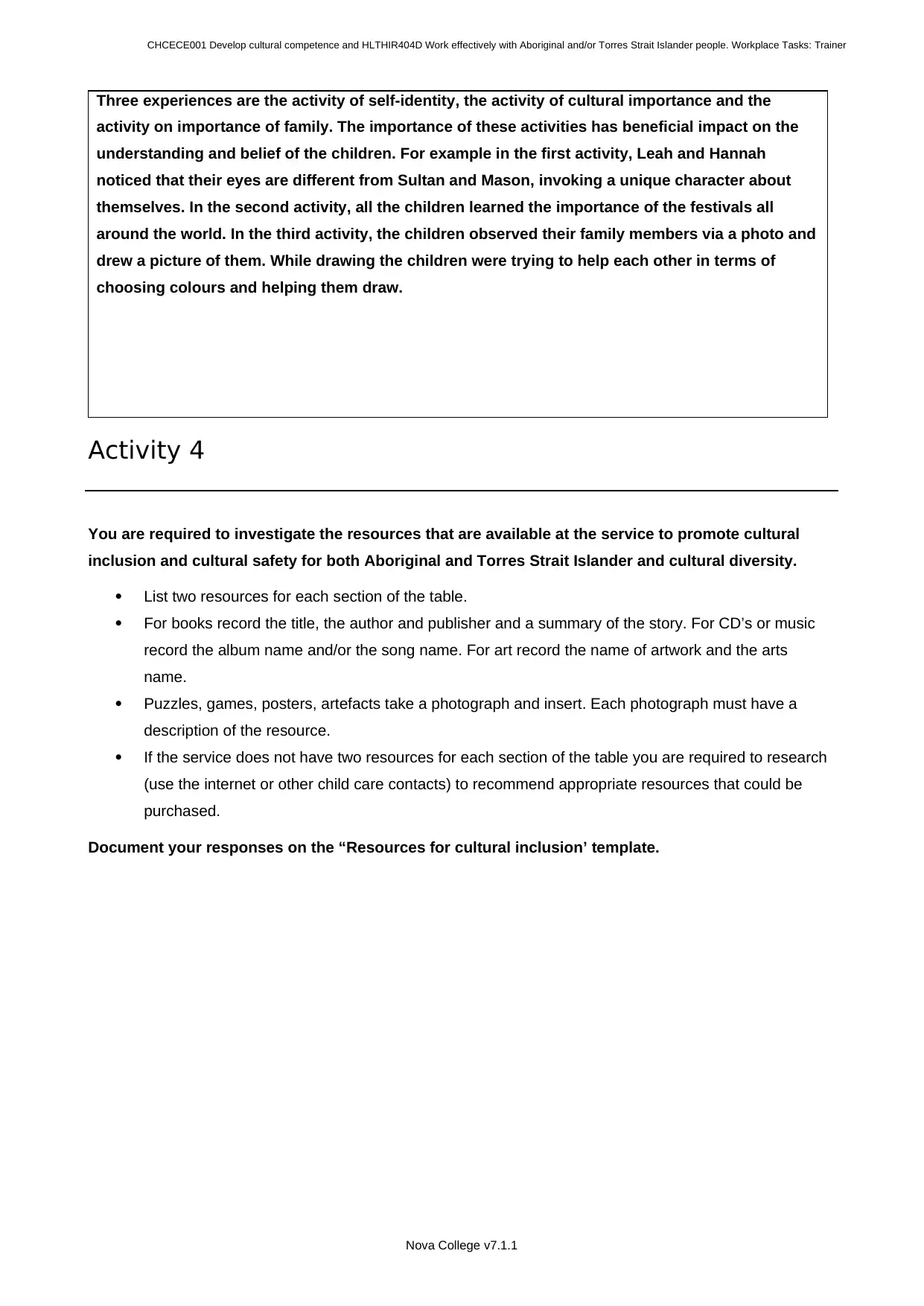
CHCECE001 Develop cultural competence and HLTHIR404D Work effectively with Aboriginal and/or Torres Strait Islander people. Workplace Tasks: Trainer
Three experiences are the activity of self-identity, the activity of cultural importance and the
activity on importance of family. The importance of these activities has beneficial impact on the
understanding and belief of the children. For example in the first activity, Leah and Hannah
noticed that their eyes are different from Sultan and Mason, invoking a unique character about
themselves. In the second activity, all the children learned the importance of the festivals all
around the world. In the third activity, the children observed their family members via a photo and
drew a picture of them. While drawing the children were trying to help each other in terms of
choosing colours and helping them draw.
Activity 4
You are required to investigate the resources that are available at the service to promote cultural
inclusion and cultural safety for both Aboriginal and Torres Strait Islander and cultural diversity.
List two resources for each section of the table.
For books record the title, the author and publisher and a summary of the story. For CD’s or music
record the album name and/or the song name. For art record the name of artwork and the arts
name.
Puzzles, games, posters, artefacts take a photograph and insert. Each photograph must have a
description of the resource.
If the service does not have two resources for each section of the table you are required to research
(use the internet or other child care contacts) to recommend appropriate resources that could be
purchased.
Document your responses on the “Resources for cultural inclusion’ template.
Nova College v7.1.1
Three experiences are the activity of self-identity, the activity of cultural importance and the
activity on importance of family. The importance of these activities has beneficial impact on the
understanding and belief of the children. For example in the first activity, Leah and Hannah
noticed that their eyes are different from Sultan and Mason, invoking a unique character about
themselves. In the second activity, all the children learned the importance of the festivals all
around the world. In the third activity, the children observed their family members via a photo and
drew a picture of them. While drawing the children were trying to help each other in terms of
choosing colours and helping them draw.
Activity 4
You are required to investigate the resources that are available at the service to promote cultural
inclusion and cultural safety for both Aboriginal and Torres Strait Islander and cultural diversity.
List two resources for each section of the table.
For books record the title, the author and publisher and a summary of the story. For CD’s or music
record the album name and/or the song name. For art record the name of artwork and the arts
name.
Puzzles, games, posters, artefacts take a photograph and insert. Each photograph must have a
description of the resource.
If the service does not have two resources for each section of the table you are required to research
(use the internet or other child care contacts) to recommend appropriate resources that could be
purchased.
Document your responses on the “Resources for cultural inclusion’ template.
Nova College v7.1.1
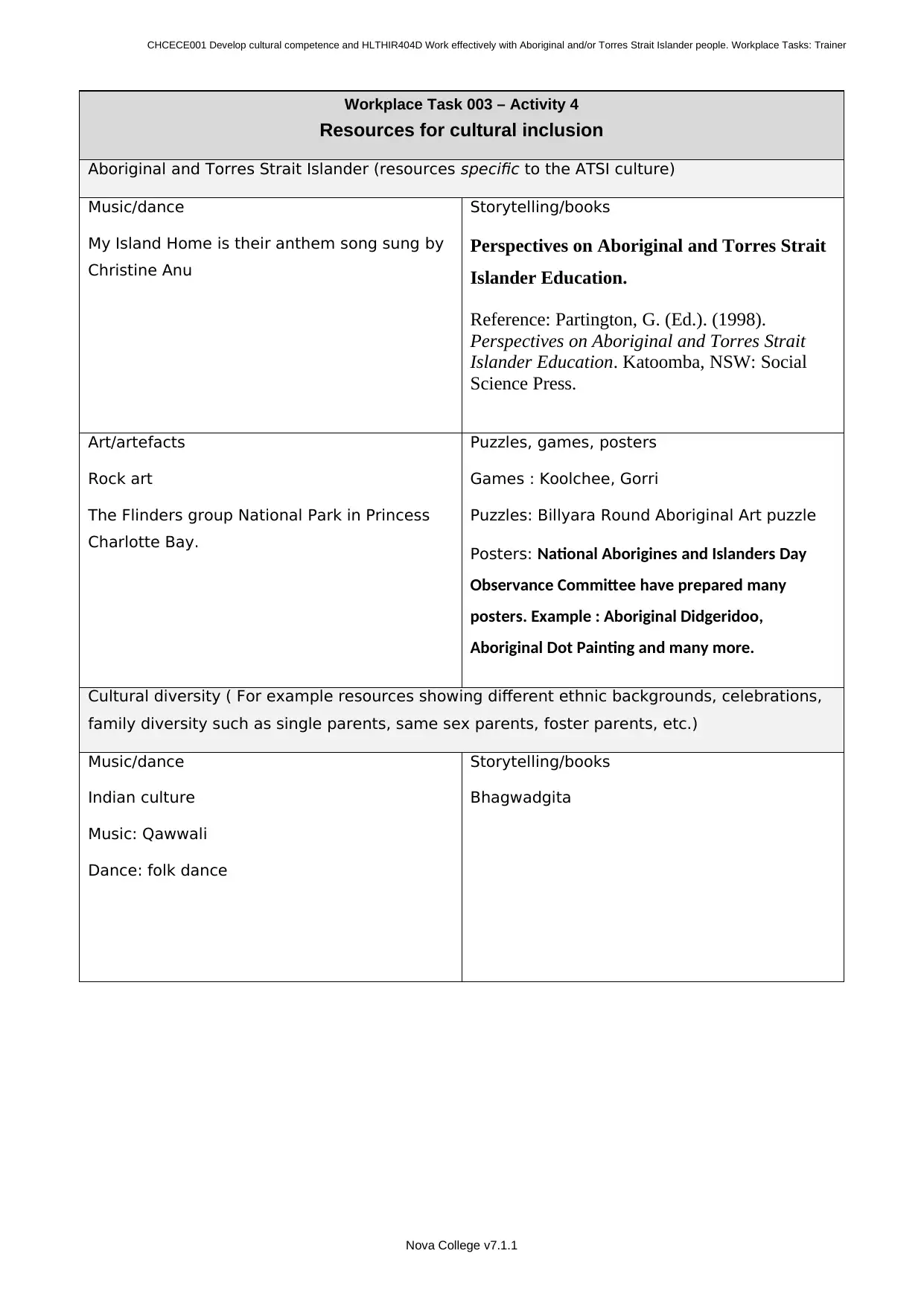
CHCECE001 Develop cultural competence and HLTHIR404D Work effectively with Aboriginal and/or Torres Strait Islander people. Workplace Tasks: Trainer
Workplace Task 003 – Activity 4
Resources for cultural inclusion
Aboriginal and Torres Strait Islander (resources specific to the ATSI culture)
Music/dance
My Island Home is their anthem song sung by
Christine Anu
Storytelling/books
Perspectives on Aboriginal and Torres Strait
Islander Education.
Reference: Partington, G. (Ed.). (1998).
Perspectives on Aboriginal and Torres Strait
Islander Education. Katoomba, NSW: Social
Science Press.
Art/artefacts
Rock art
The Flinders group National Park in Princess
Charlotte Bay.
Puzzles, games, posters
Games : Koolchee, Gorri
Puzzles: Billyara Round Aboriginal Art puzzle
Posters: National Aborigines and Islanders Day
Observance Committee have prepared many
posters. Example : Aboriginal Didgeridoo,
Aboriginal Dot Painting and many more.
Cultural diversity ( For example resources showing different ethnic backgrounds, celebrations,
family diversity such as single parents, same sex parents, foster parents, etc.)
Music/dance
Indian culture
Music: Qawwali
Dance: folk dance
Storytelling/books
Bhagwadgita
Nova College v7.1.1
Workplace Task 003 – Activity 4
Resources for cultural inclusion
Aboriginal and Torres Strait Islander (resources specific to the ATSI culture)
Music/dance
My Island Home is their anthem song sung by
Christine Anu
Storytelling/books
Perspectives on Aboriginal and Torres Strait
Islander Education.
Reference: Partington, G. (Ed.). (1998).
Perspectives on Aboriginal and Torres Strait
Islander Education. Katoomba, NSW: Social
Science Press.
Art/artefacts
Rock art
The Flinders group National Park in Princess
Charlotte Bay.
Puzzles, games, posters
Games : Koolchee, Gorri
Puzzles: Billyara Round Aboriginal Art puzzle
Posters: National Aborigines and Islanders Day
Observance Committee have prepared many
posters. Example : Aboriginal Didgeridoo,
Aboriginal Dot Painting and many more.
Cultural diversity ( For example resources showing different ethnic backgrounds, celebrations,
family diversity such as single parents, same sex parents, foster parents, etc.)
Music/dance
Indian culture
Music: Qawwali
Dance: folk dance
Storytelling/books
Bhagwadgita
Nova College v7.1.1
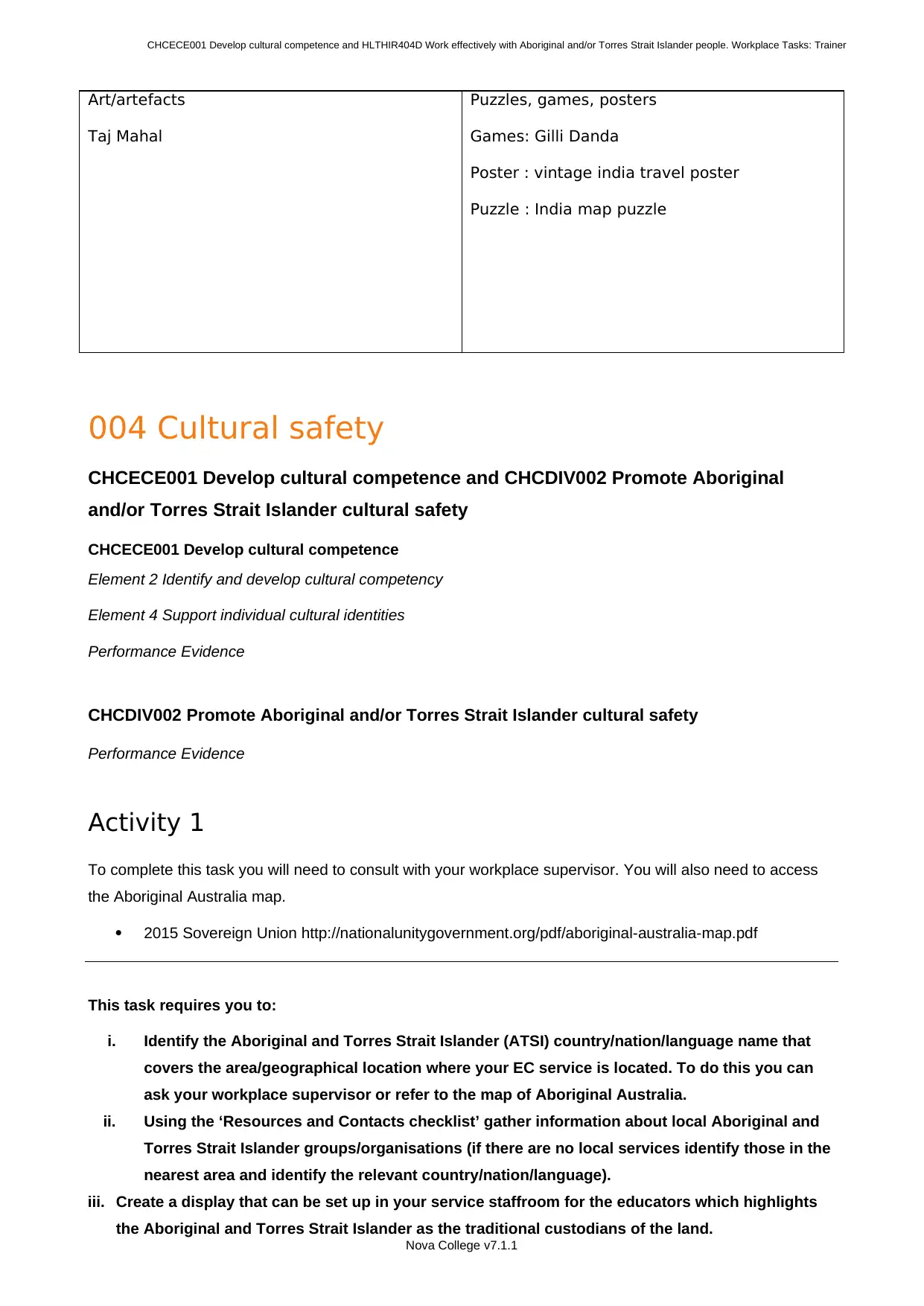
CHCECE001 Develop cultural competence and HLTHIR404D Work effectively with Aboriginal and/or Torres Strait Islander people. Workplace Tasks: Trainer
Art/artefacts
Taj Mahal
Puzzles, games, posters
Games: Gilli Danda
Poster : vintage india travel poster
Puzzle : India map puzzle
004 Cultural safety
CHCECE001 Develop cultural competence and CHCDIV002 Promote Aboriginal
and/or Torres Strait Islander cultural safety
CHCECE001 Develop cultural competence
Element 2 Identify and develop cultural competency
Element 4 Support individual cultural identities
Performance Evidence
CHCDIV002 Promote Aboriginal and/or Torres Strait Islander cultural safety
Performance Evidence
Activity 1
To complete this task you will need to consult with your workplace supervisor. You will also need to access
the Aboriginal Australia map.
2015 Sovereign Union http://nationalunitygovernment.org/pdf/aboriginal-australia-map.pdf
This task requires you to:
i. Identify the Aboriginal and Torres Strait Islander (ATSI) country/nation/language name that
covers the area/geographical location where your EC service is located. To do this you can
ask your workplace supervisor or refer to the map of Aboriginal Australia.
ii. Using the ‘Resources and Contacts checklist’ gather information about local Aboriginal and
Torres Strait Islander groups/organisations (if there are no local services identify those in the
nearest area and identify the relevant country/nation/language).
iii. Create a display that can be set up in your service staffroom for the educators which highlights
the Aboriginal and Torres Strait Islander as the traditional custodians of the land.
Nova College v7.1.1
Art/artefacts
Taj Mahal
Puzzles, games, posters
Games: Gilli Danda
Poster : vintage india travel poster
Puzzle : India map puzzle
004 Cultural safety
CHCECE001 Develop cultural competence and CHCDIV002 Promote Aboriginal
and/or Torres Strait Islander cultural safety
CHCECE001 Develop cultural competence
Element 2 Identify and develop cultural competency
Element 4 Support individual cultural identities
Performance Evidence
CHCDIV002 Promote Aboriginal and/or Torres Strait Islander cultural safety
Performance Evidence
Activity 1
To complete this task you will need to consult with your workplace supervisor. You will also need to access
the Aboriginal Australia map.
2015 Sovereign Union http://nationalunitygovernment.org/pdf/aboriginal-australia-map.pdf
This task requires you to:
i. Identify the Aboriginal and Torres Strait Islander (ATSI) country/nation/language name that
covers the area/geographical location where your EC service is located. To do this you can
ask your workplace supervisor or refer to the map of Aboriginal Australia.
ii. Using the ‘Resources and Contacts checklist’ gather information about local Aboriginal and
Torres Strait Islander groups/organisations (if there are no local services identify those in the
nearest area and identify the relevant country/nation/language).
iii. Create a display that can be set up in your service staffroom for the educators which highlights
the Aboriginal and Torres Strait Islander as the traditional custodians of the land.
Nova College v7.1.1
Paraphrase This Document
Need a fresh take? Get an instant paraphrase of this document with our AI Paraphraser
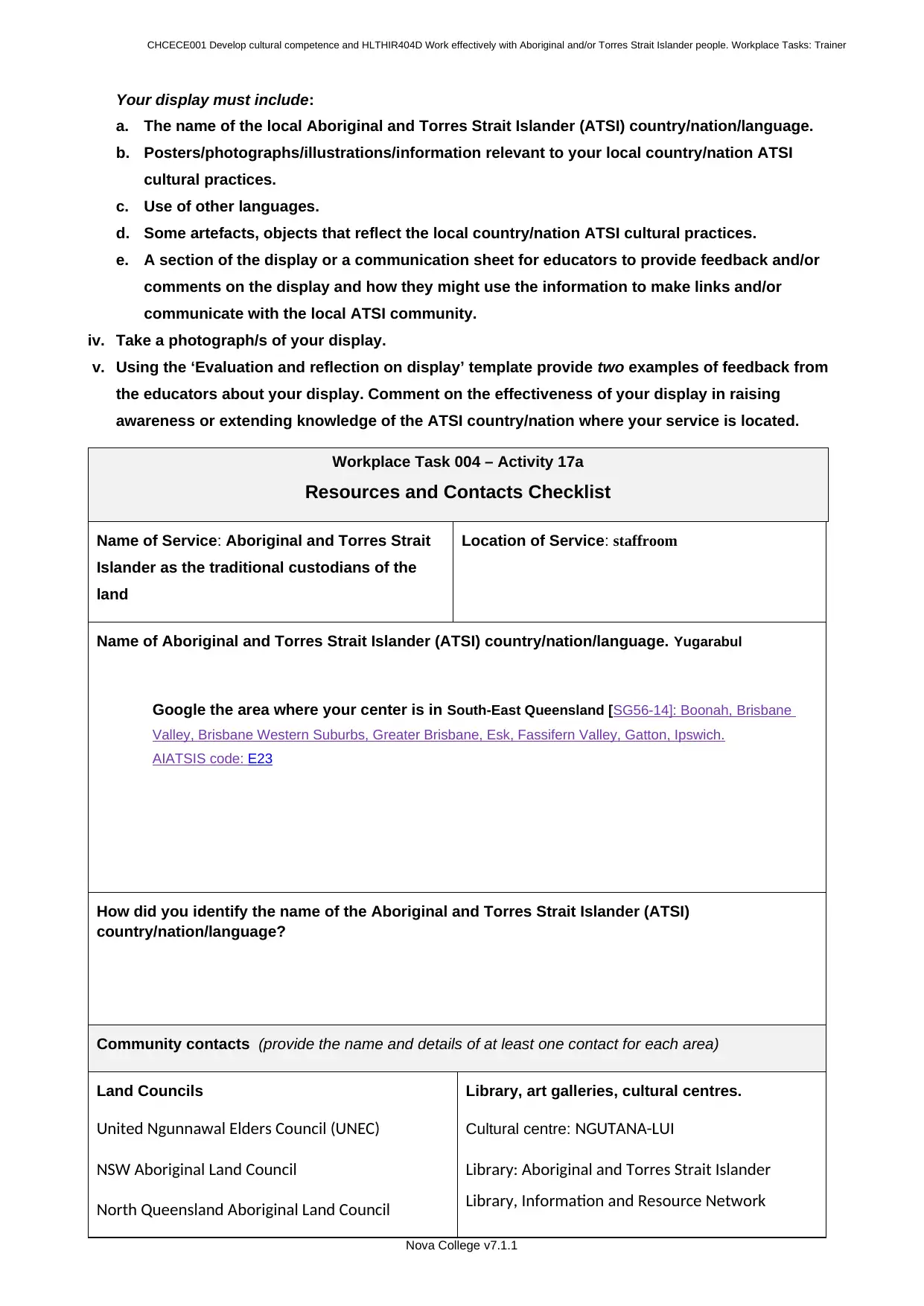
CHCECE001 Develop cultural competence and HLTHIR404D Work effectively with Aboriginal and/or Torres Strait Islander people. Workplace Tasks: Trainer
Your display must include:
a. The name of the local Aboriginal and Torres Strait Islander (ATSI) country/nation/language.
b. Posters/photographs/illustrations/information relevant to your local country/nation ATSI
cultural practices.
c. Use of other languages.
d. Some artefacts, objects that reflect the local country/nation ATSI cultural practices.
e. A section of the display or a communication sheet for educators to provide feedback and/or
comments on the display and how they might use the information to make links and/or
communicate with the local ATSI community.
iv. Take a photograph/s of your display.
v. Using the ‘Evaluation and reflection on display’ template provide two examples of feedback from
the educators about your display. Comment on the effectiveness of your display in raising
awareness or extending knowledge of the ATSI country/nation where your service is located.
Workplace Task 004 – Activity 17a
Resources and Contacts Checklist
Name of Service: Aboriginal and Torres Strait
Islander as the traditional custodians of the
land
Location of Service: staffroom
Name of Aboriginal and Torres Strait Islander (ATSI) country/nation/language. Yugarabul
Google the area where your center is in South-East Queensland [SG56-14]: Boonah, Brisbane
Valley, Brisbane Western Suburbs, Greater Brisbane, Esk, Fassifern Valley, Gatton, Ipswich.
AIATSIS code: E23
How did you identify the name of the Aboriginal and Torres Strait Islander (ATSI)
country/nation/language?
Community contacts (provide the name and details of at least one contact for each area)
Land Councils
United Ngunnawal Elders Council (UNEC)
NSW Aboriginal Land Council
North Queensland Aboriginal Land Council
Library, art galleries, cultural centres.
Cultural centre: NGUTANA-LUI
Library: Aboriginal and Torres Strait Islander
Library, Information and Resource Network
Nova College v7.1.1
Your display must include:
a. The name of the local Aboriginal and Torres Strait Islander (ATSI) country/nation/language.
b. Posters/photographs/illustrations/information relevant to your local country/nation ATSI
cultural practices.
c. Use of other languages.
d. Some artefacts, objects that reflect the local country/nation ATSI cultural practices.
e. A section of the display or a communication sheet for educators to provide feedback and/or
comments on the display and how they might use the information to make links and/or
communicate with the local ATSI community.
iv. Take a photograph/s of your display.
v. Using the ‘Evaluation and reflection on display’ template provide two examples of feedback from
the educators about your display. Comment on the effectiveness of your display in raising
awareness or extending knowledge of the ATSI country/nation where your service is located.
Workplace Task 004 – Activity 17a
Resources and Contacts Checklist
Name of Service: Aboriginal and Torres Strait
Islander as the traditional custodians of the
land
Location of Service: staffroom
Name of Aboriginal and Torres Strait Islander (ATSI) country/nation/language. Yugarabul
Google the area where your center is in South-East Queensland [SG56-14]: Boonah, Brisbane
Valley, Brisbane Western Suburbs, Greater Brisbane, Esk, Fassifern Valley, Gatton, Ipswich.
AIATSIS code: E23
How did you identify the name of the Aboriginal and Torres Strait Islander (ATSI)
country/nation/language?
Community contacts (provide the name and details of at least one contact for each area)
Land Councils
United Ngunnawal Elders Council (UNEC)
NSW Aboriginal Land Council
North Queensland Aboriginal Land Council
Library, art galleries, cultural centres.
Cultural centre: NGUTANA-LUI
Library: Aboriginal and Torres Strait Islander
Library, Information and Resource Network
Nova College v7.1.1
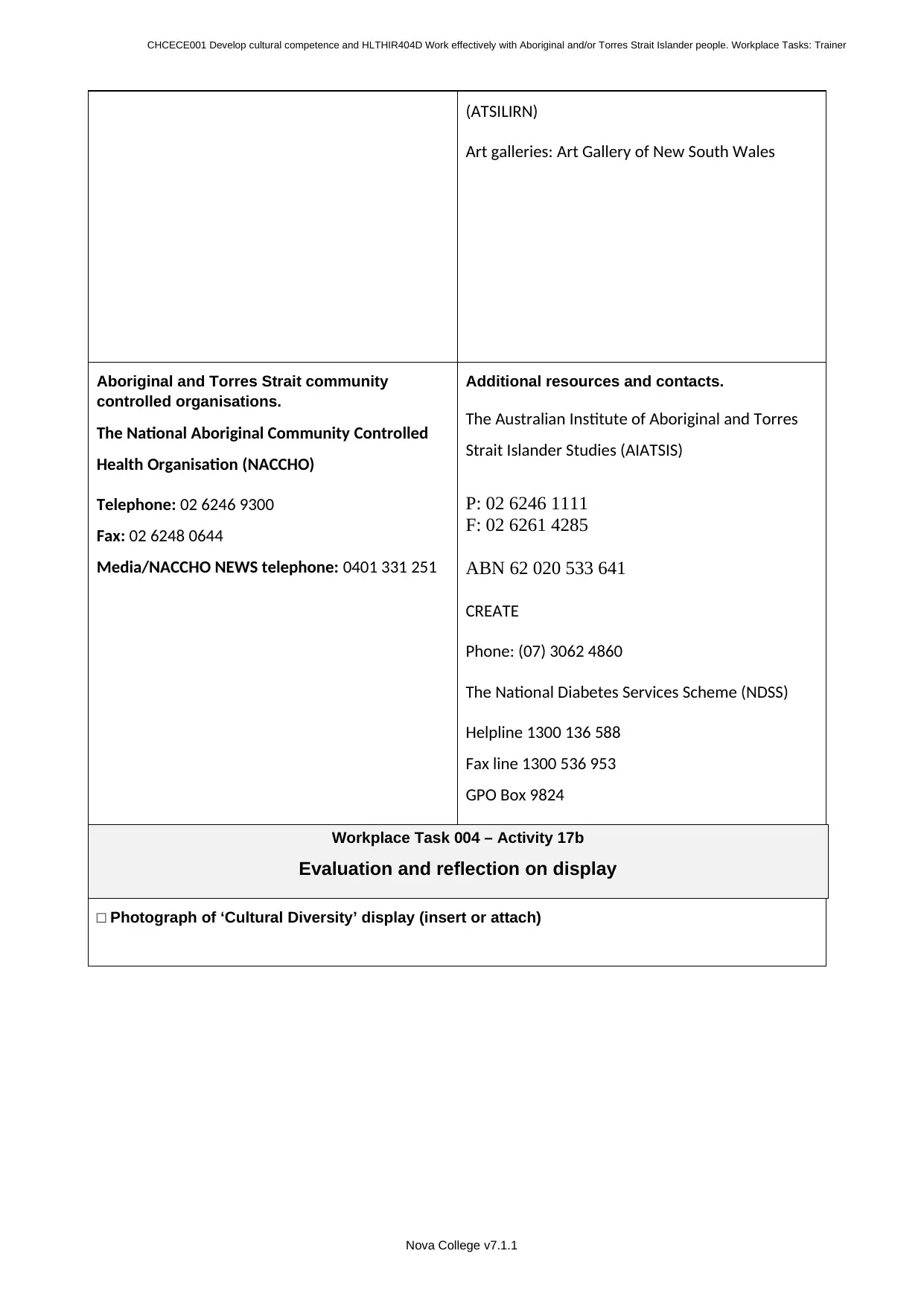
CHCECE001 Develop cultural competence and HLTHIR404D Work effectively with Aboriginal and/or Torres Strait Islander people. Workplace Tasks: Trainer
(ATSILIRN)
Art galleries: Art Gallery of New South Wales
Aboriginal and Torres Strait community
controlled organisations.
The National Aboriginal Community Controlled
Health Organisation (NACCHO)
Telephone: 02 6246 9300
Fax: 02 6248 0644
Media/NACCHO NEWS telephone: 0401 331 251
Additional resources and contacts.
The Australian Institute of Aboriginal and Torres
Strait Islander Studies (AIATSIS)
P: 02 6246 1111
F: 02 6261 4285
ABN 62 020 533 641
CREATE
Phone: (07) 3062 4860
The National Diabetes Services Scheme (NDSS)
Helpline 1300 136 588
Fax line 1300 536 953
GPO Box 9824
Workplace Task 004 – Activity 17b
Evaluation and reflection on display
□ Photograph of ‘Cultural Diversity’ display (insert or attach)
Nova College v7.1.1
(ATSILIRN)
Art galleries: Art Gallery of New South Wales
Aboriginal and Torres Strait community
controlled organisations.
The National Aboriginal Community Controlled
Health Organisation (NACCHO)
Telephone: 02 6246 9300
Fax: 02 6248 0644
Media/NACCHO NEWS telephone: 0401 331 251
Additional resources and contacts.
The Australian Institute of Aboriginal and Torres
Strait Islander Studies (AIATSIS)
P: 02 6246 1111
F: 02 6261 4285
ABN 62 020 533 641
CREATE
Phone: (07) 3062 4860
The National Diabetes Services Scheme (NDSS)
Helpline 1300 136 588
Fax line 1300 536 953
GPO Box 9824
Workplace Task 004 – Activity 17b
Evaluation and reflection on display
□ Photograph of ‘Cultural Diversity’ display (insert or attach)
Nova College v7.1.1
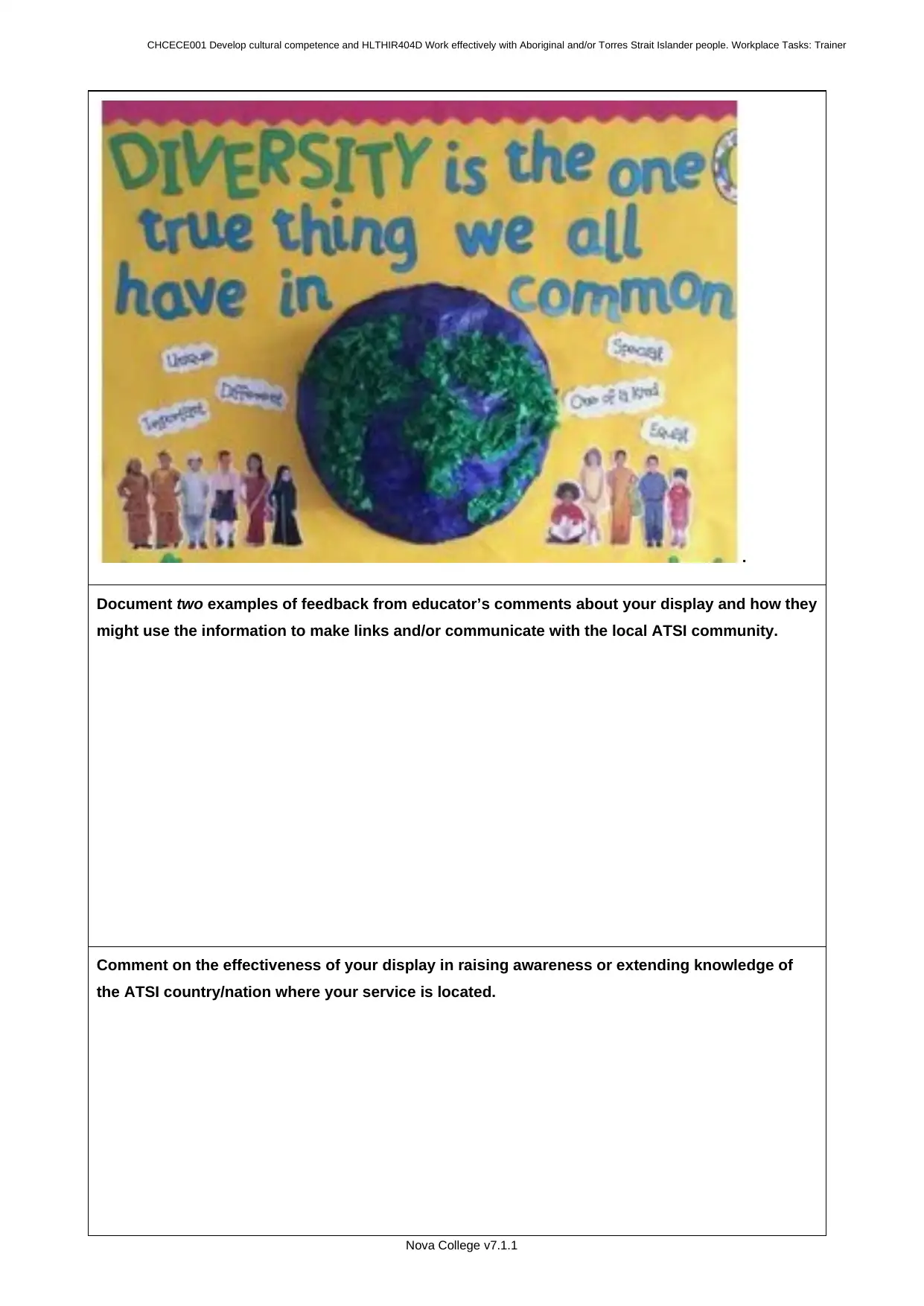
CHCECE001 Develop cultural competence and HLTHIR404D Work effectively with Aboriginal and/or Torres Strait Islander people. Workplace Tasks: Trainer
.
Document two examples of feedback from educator’s comments about your display and how they
might use the information to make links and/or communicate with the local ATSI community.
Comment on the effectiveness of your display in raising awareness or extending knowledge of
the ATSI country/nation where your service is located.
Nova College v7.1.1
.
Document two examples of feedback from educator’s comments about your display and how they
might use the information to make links and/or communicate with the local ATSI community.
Comment on the effectiveness of your display in raising awareness or extending knowledge of
the ATSI country/nation where your service is located.
Nova College v7.1.1
Secure Best Marks with AI Grader
Need help grading? Try our AI Grader for instant feedback on your assignments.

CHCECE001 Develop cultural competence and HLTHIR404D Work effectively with Aboriginal and/or Torres Strait Islander people. Workplace Tasks: Trainer
Nova College v7.1.1
Nova College v7.1.1
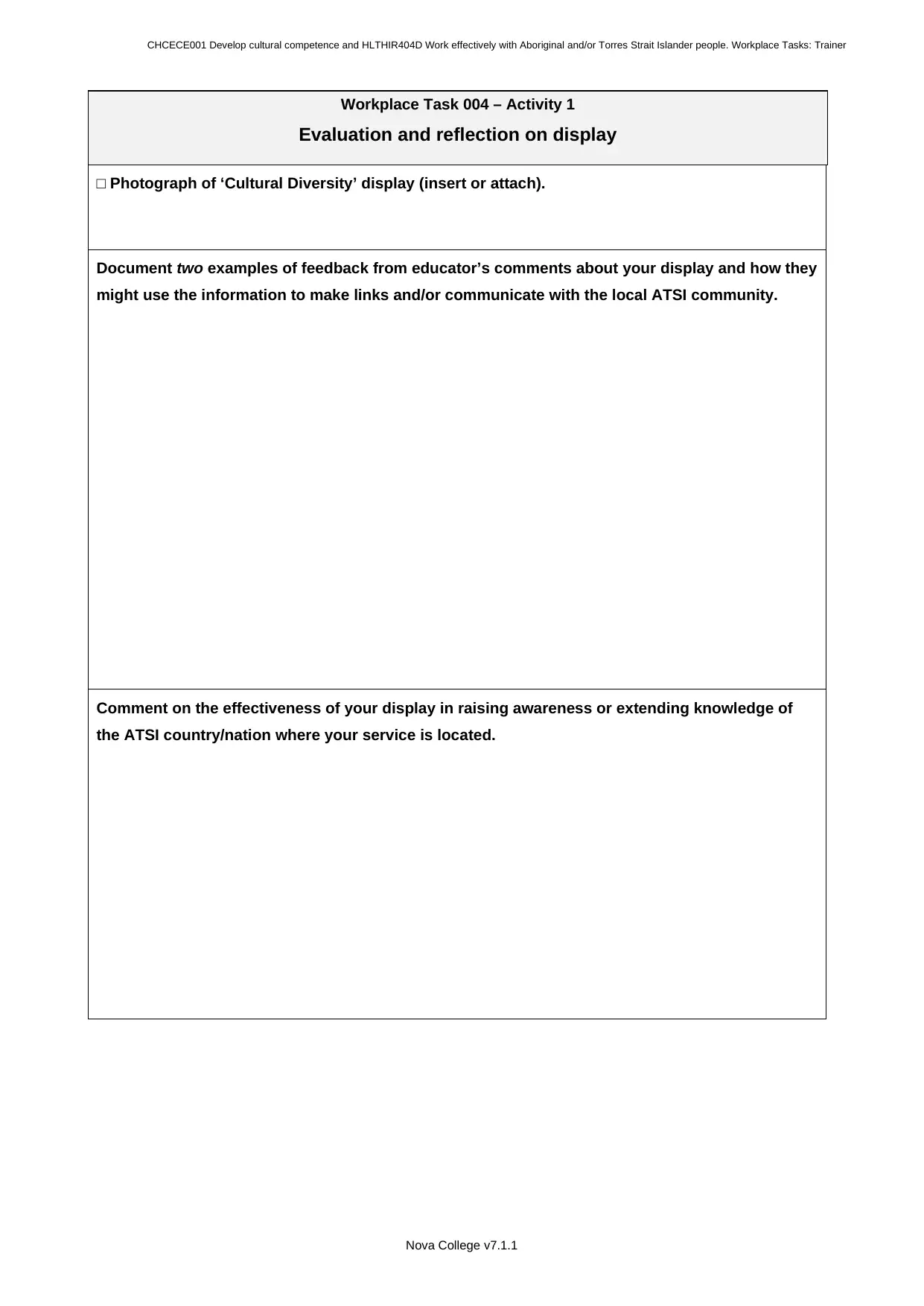
CHCECE001 Develop cultural competence and HLTHIR404D Work effectively with Aboriginal and/or Torres Strait Islander people. Workplace Tasks: Trainer
Workplace Task 004 – Activity 1
Evaluation and reflection on display
□ Photograph of ‘Cultural Diversity’ display (insert or attach).
Document two examples of feedback from educator’s comments about your display and how they
might use the information to make links and/or communicate with the local ATSI community.
Comment on the effectiveness of your display in raising awareness or extending knowledge of
the ATSI country/nation where your service is located.
Nova College v7.1.1
Workplace Task 004 – Activity 1
Evaluation and reflection on display
□ Photograph of ‘Cultural Diversity’ display (insert or attach).
Document two examples of feedback from educator’s comments about your display and how they
might use the information to make links and/or communicate with the local ATSI community.
Comment on the effectiveness of your display in raising awareness or extending knowledge of
the ATSI country/nation where your service is located.
Nova College v7.1.1
1 out of 18
Your All-in-One AI-Powered Toolkit for Academic Success.
+13062052269
info@desklib.com
Available 24*7 on WhatsApp / Email
![[object Object]](/_next/static/media/star-bottom.7253800d.svg)
Unlock your academic potential
© 2024 | Zucol Services PVT LTD | All rights reserved.





